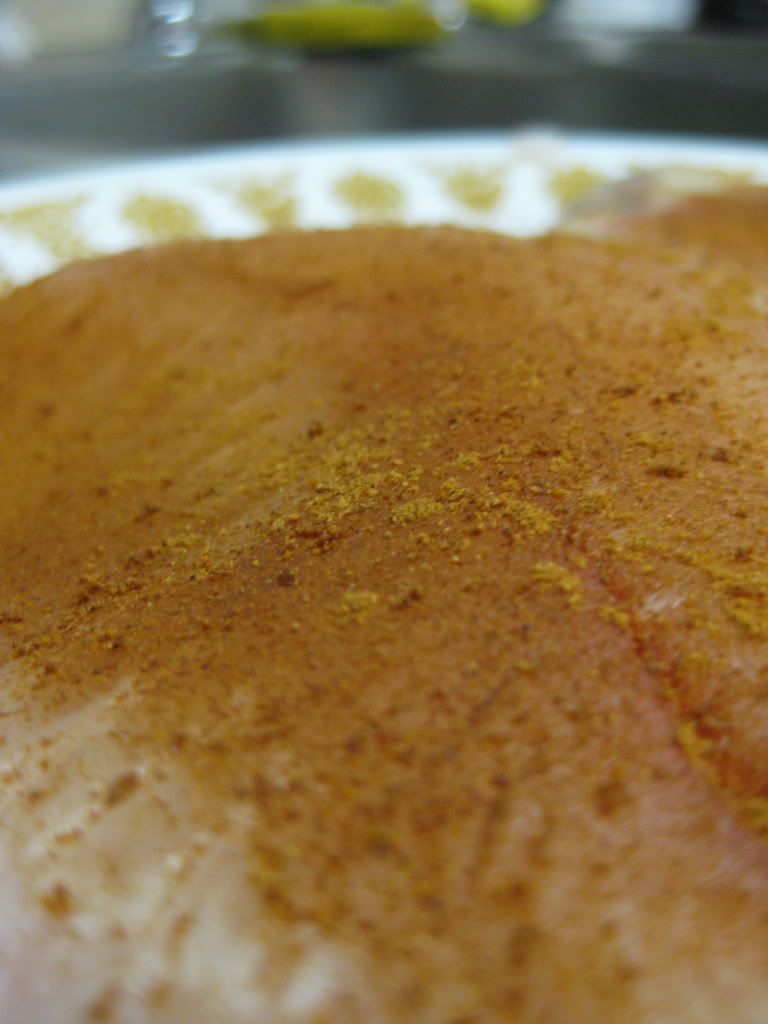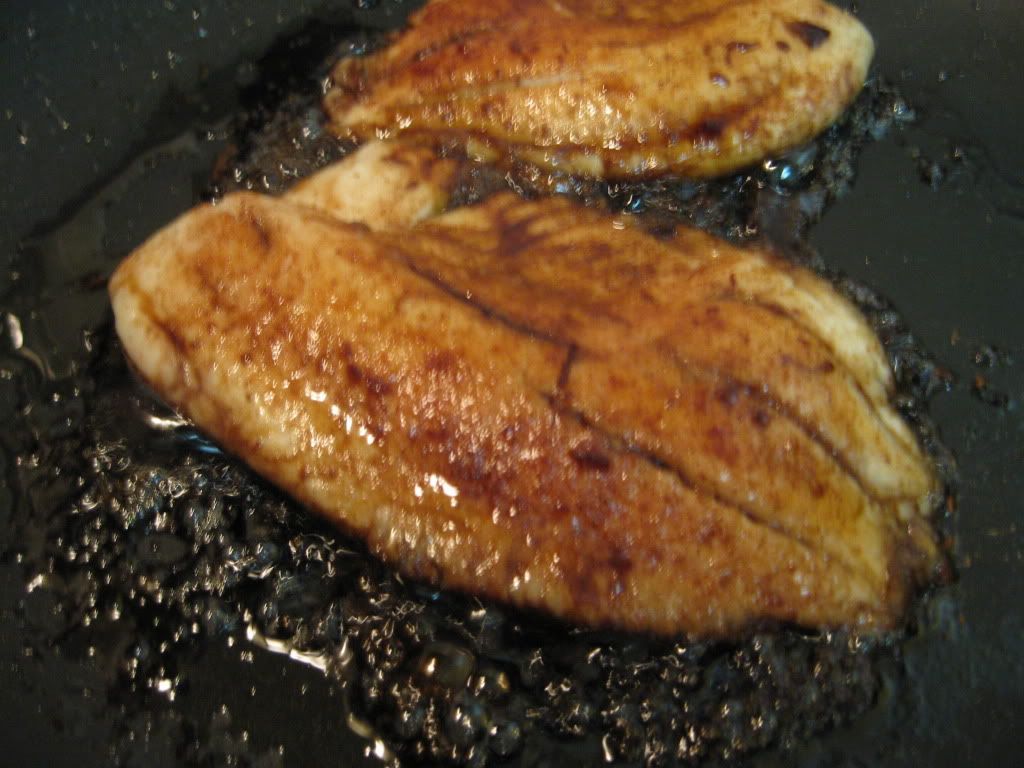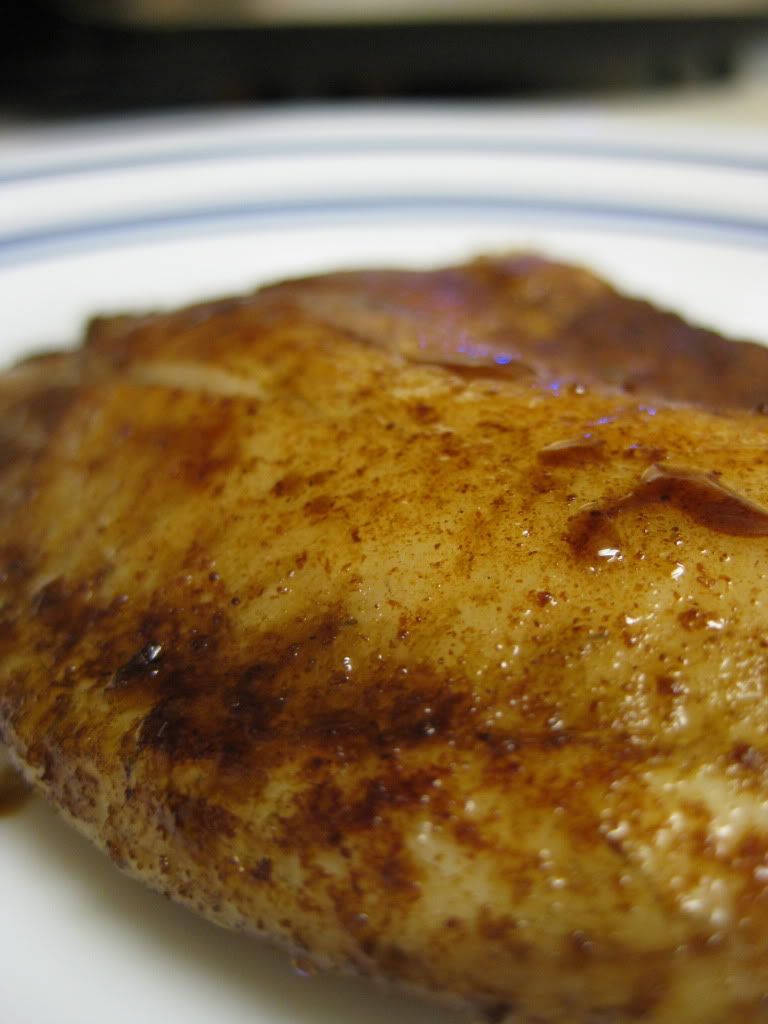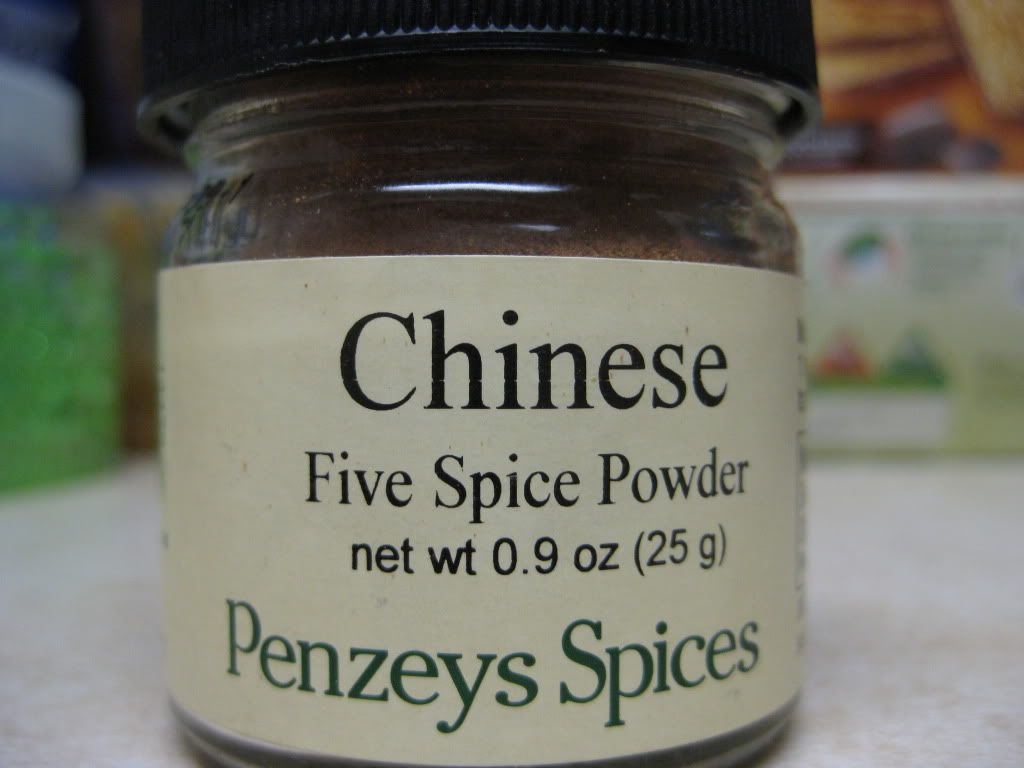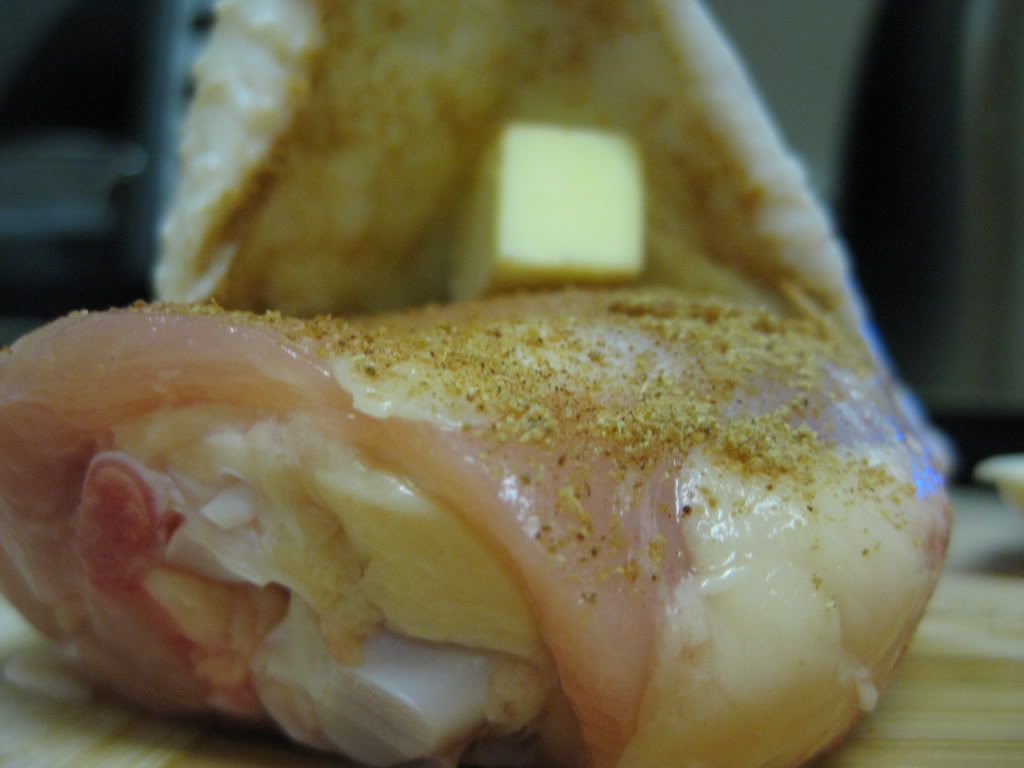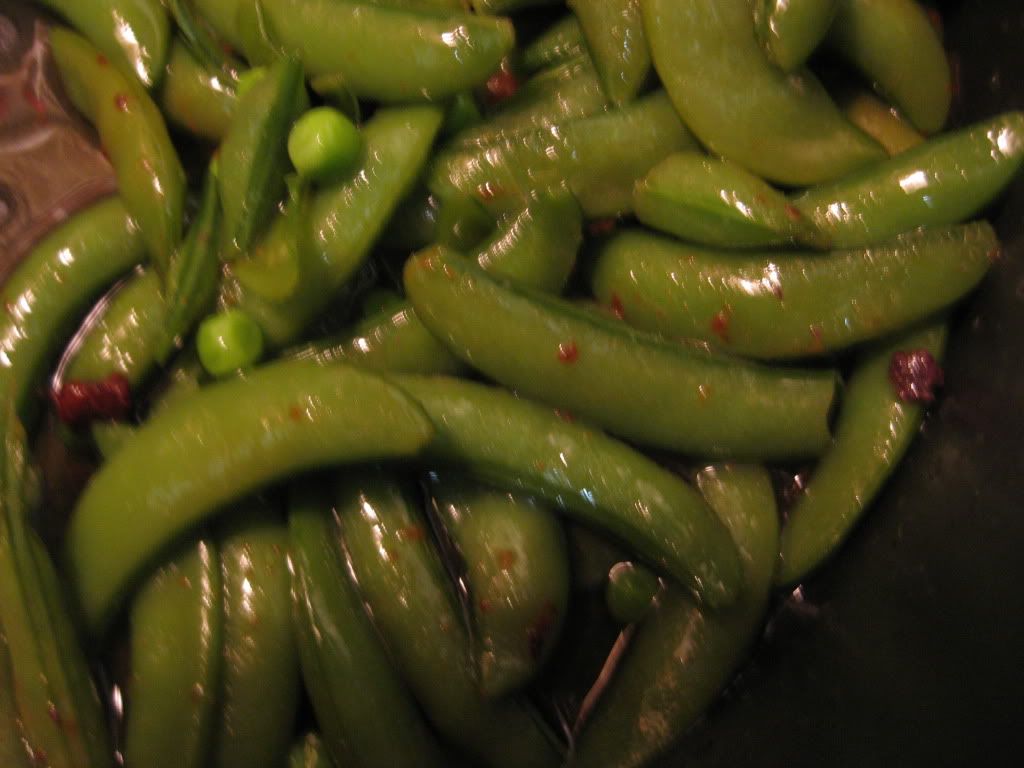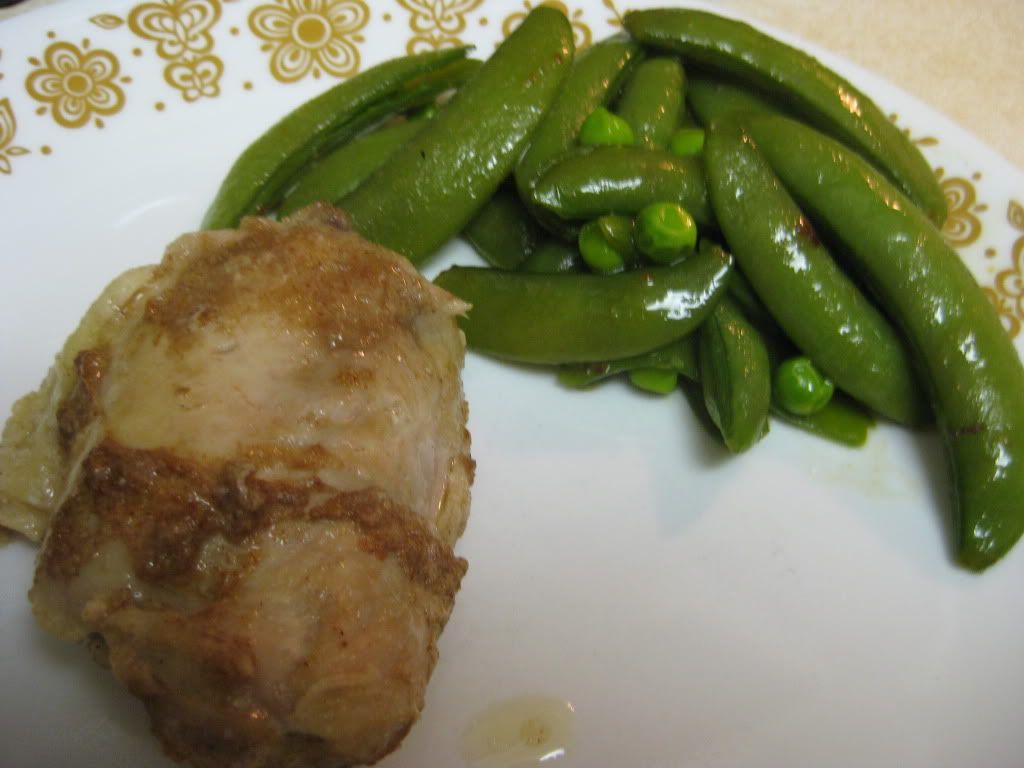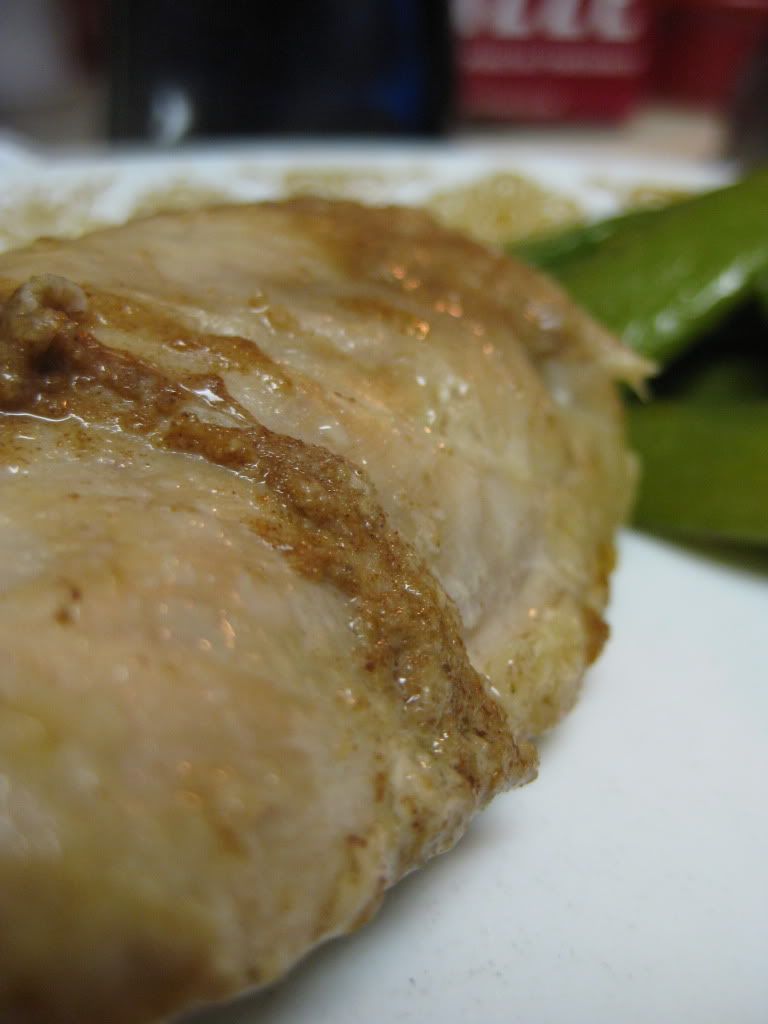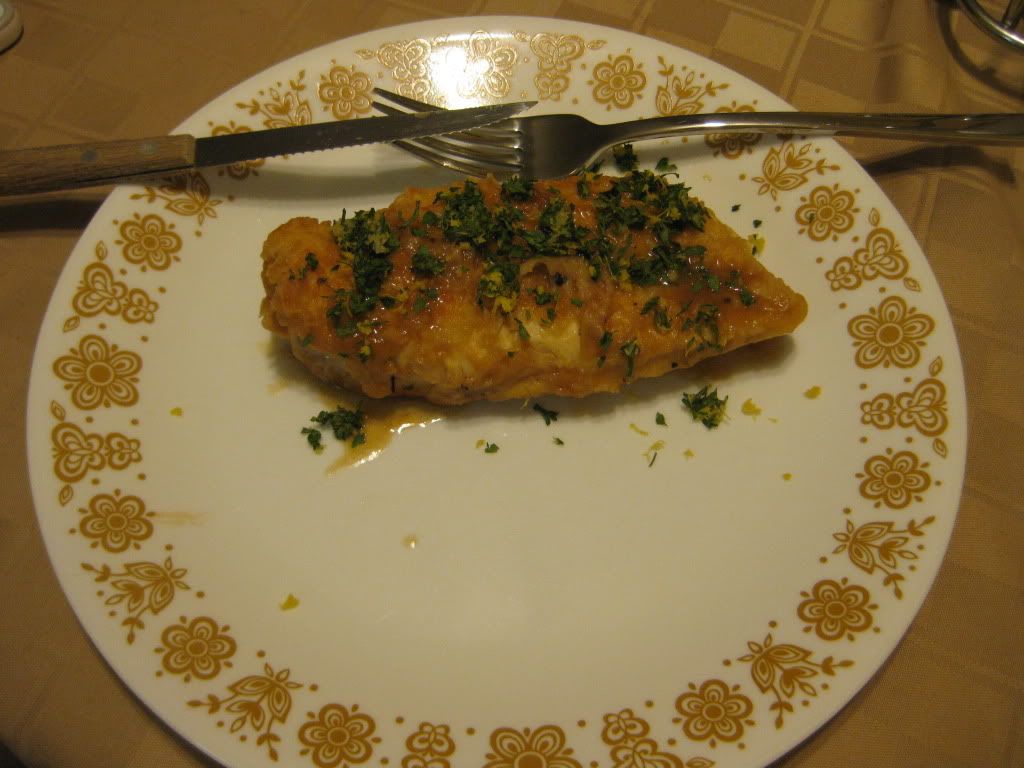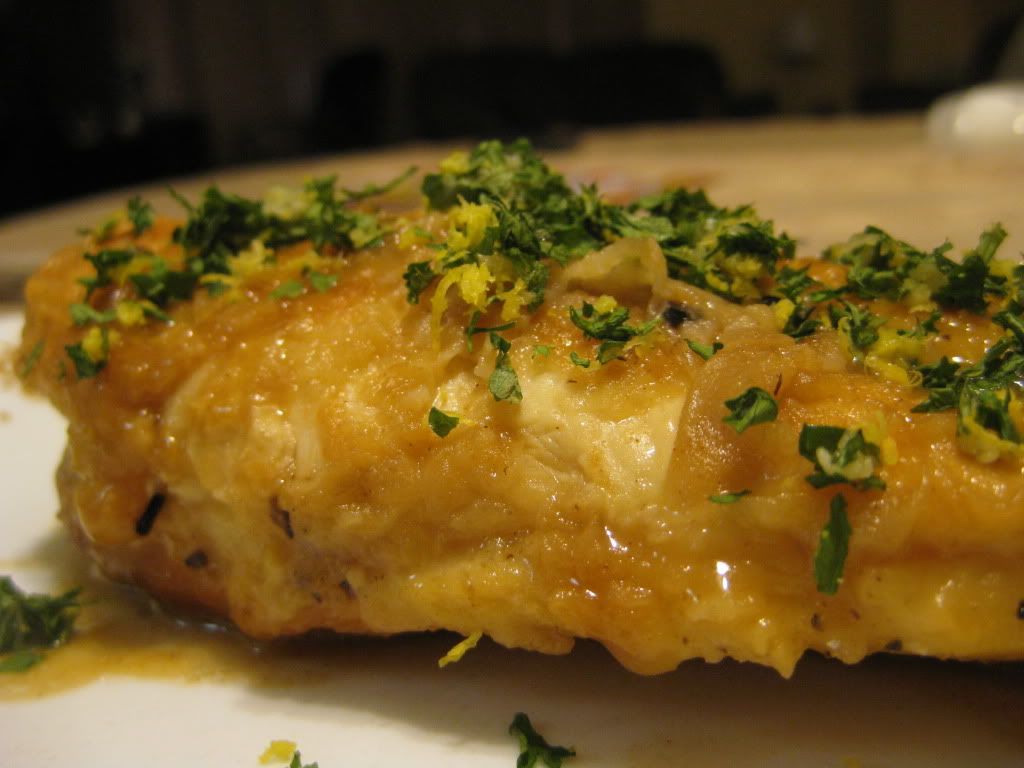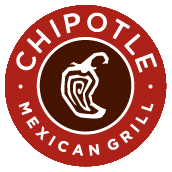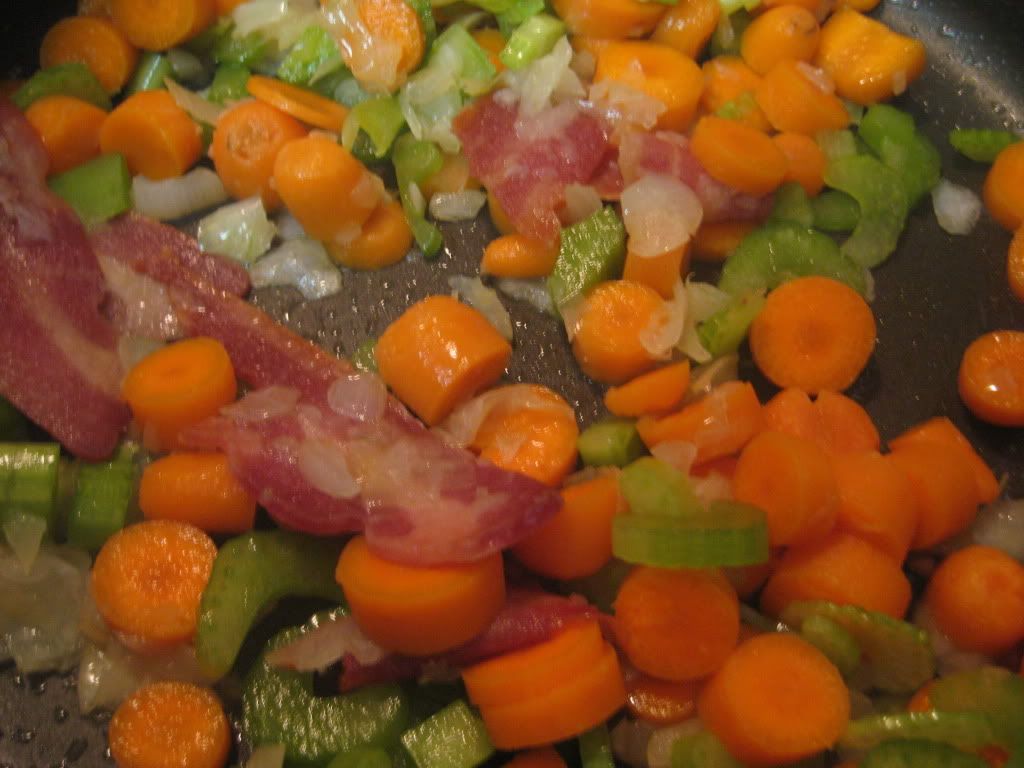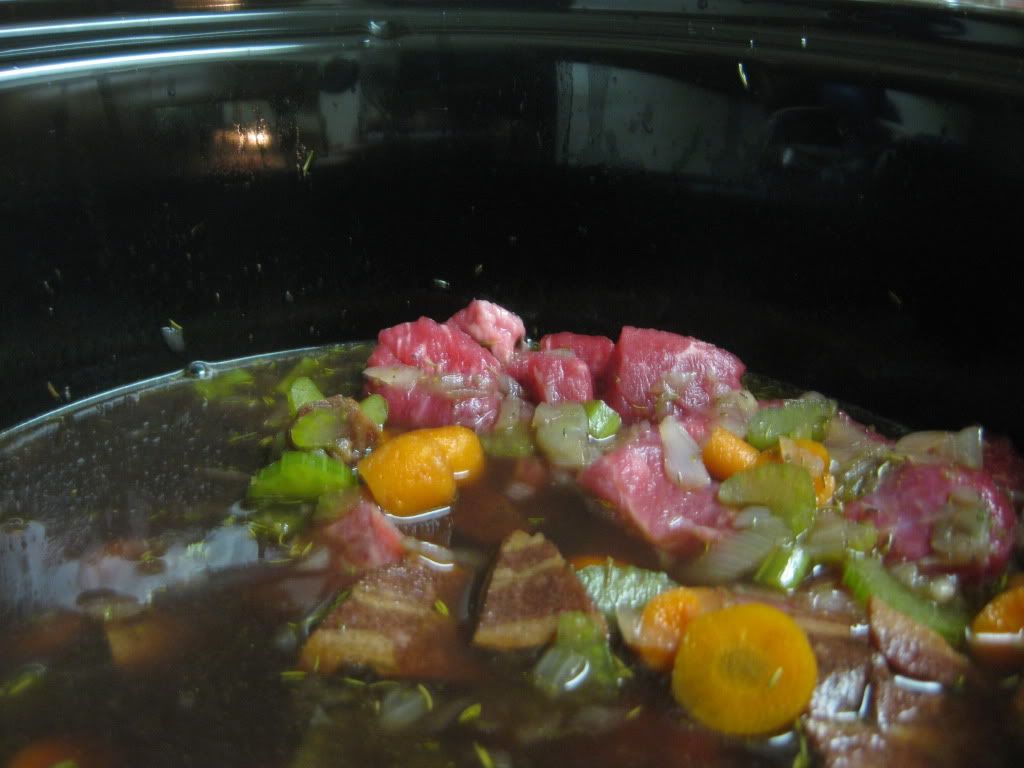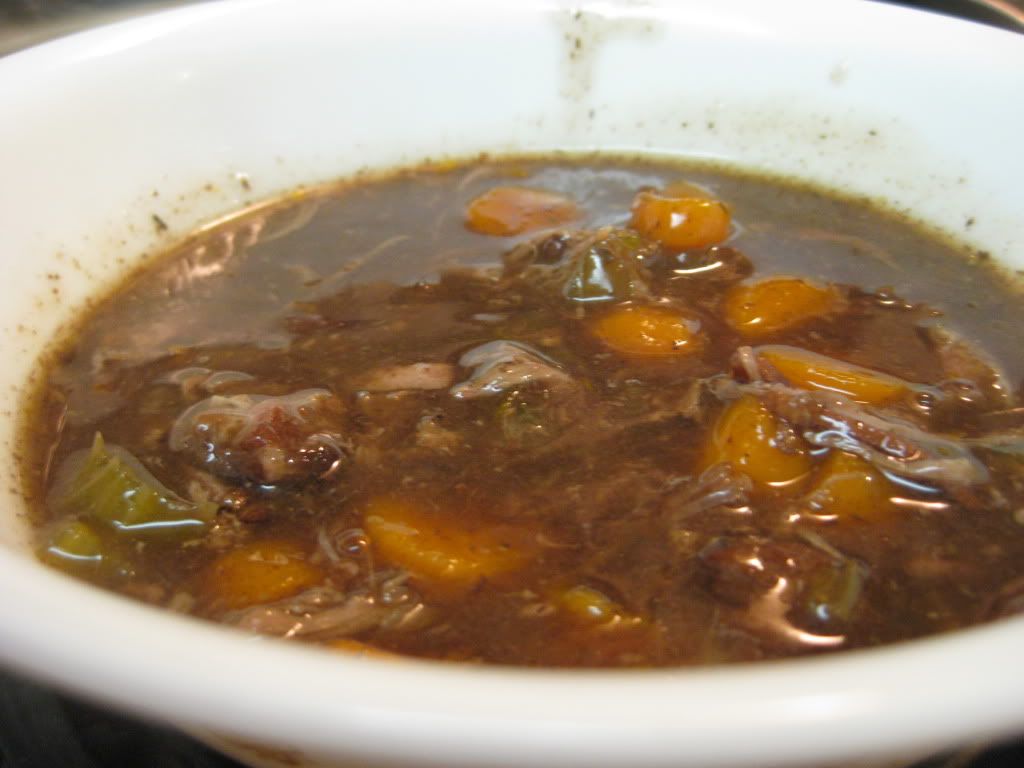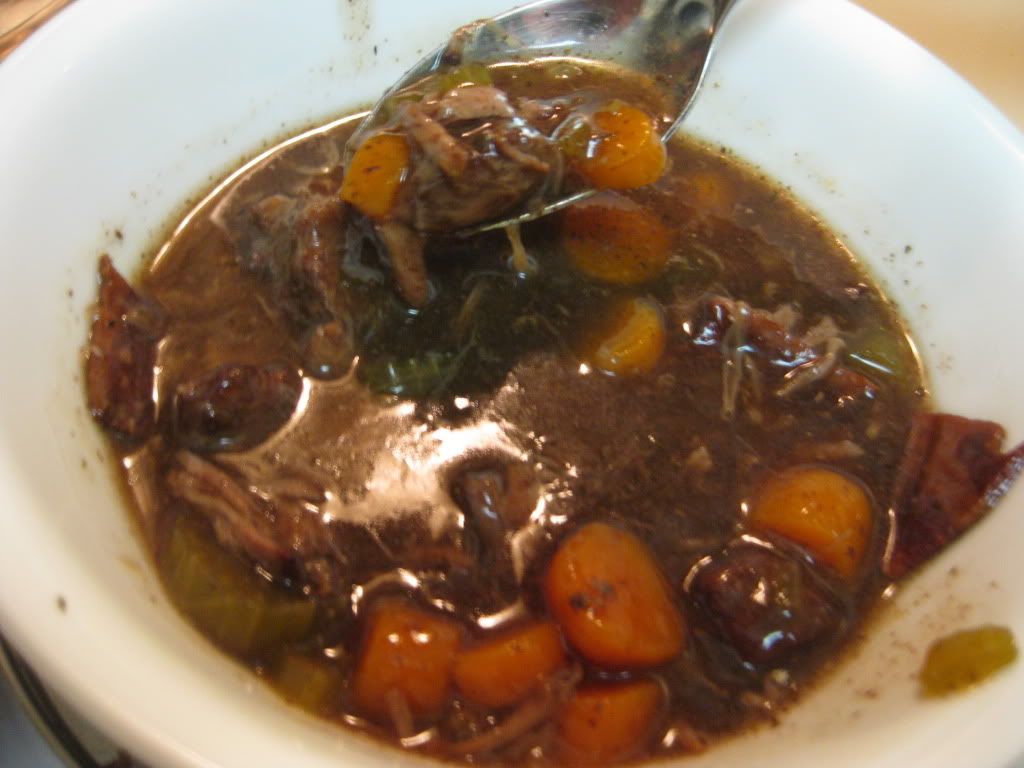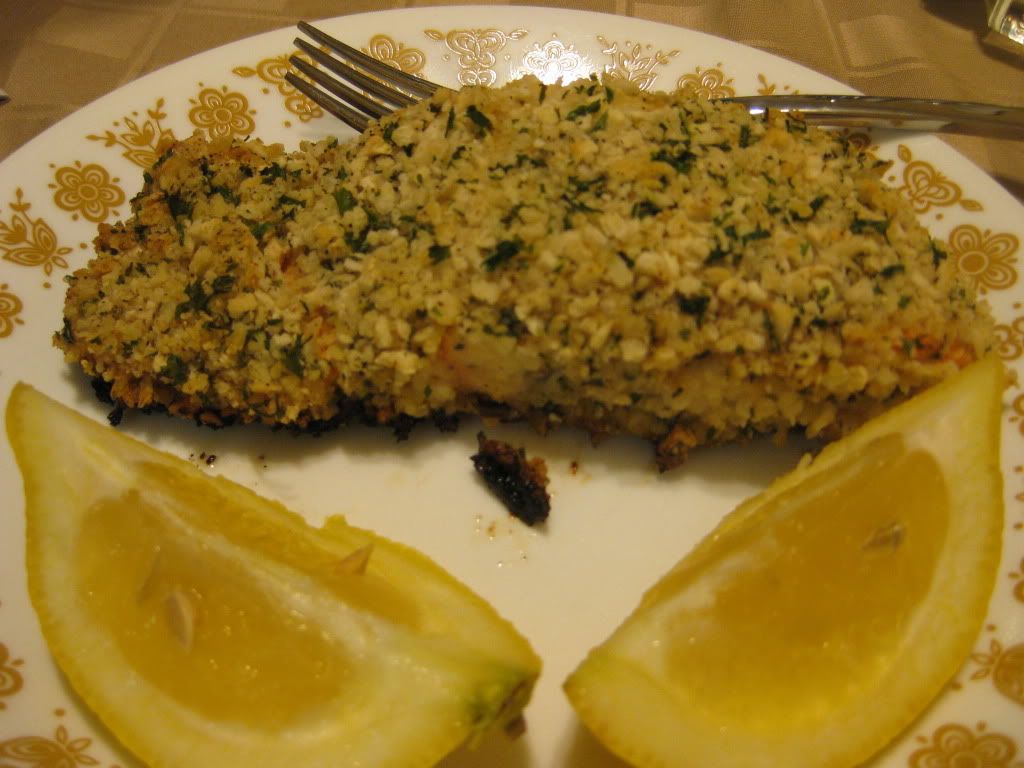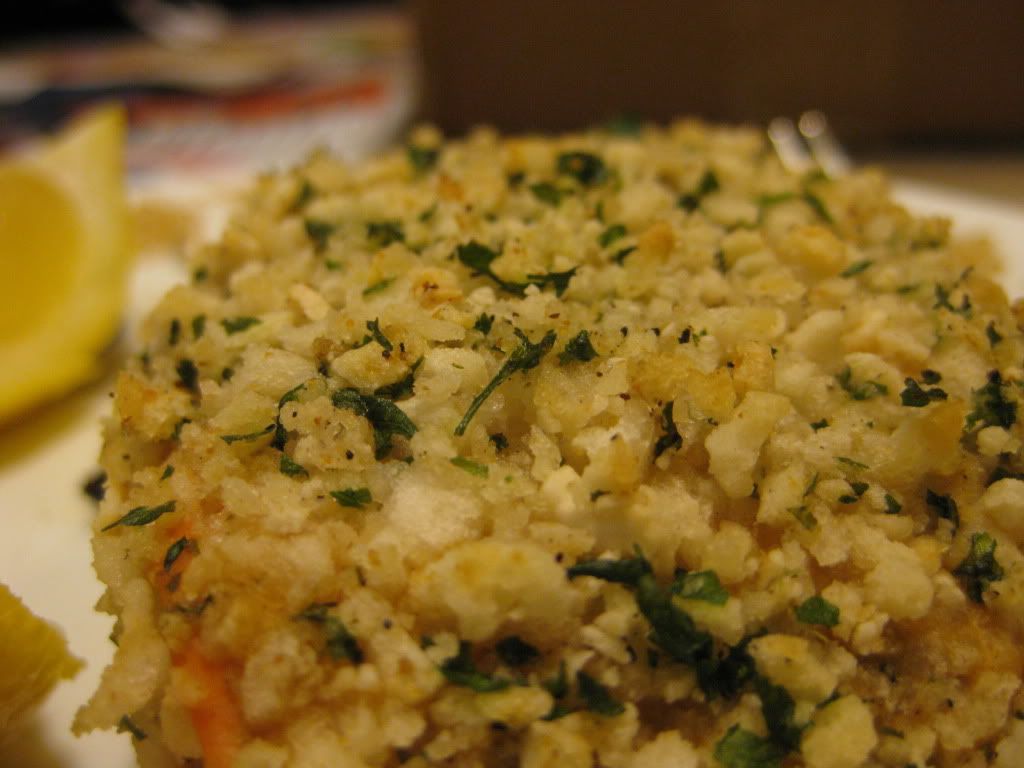Good evening everyone! We're no strangers to tilapia on the blog. The diverse little fish has been dressed up multiple ways and cooked in multiple formats over the past year and a half. In fact, we could do a spin off blog called 'Cooking With Tilapia' and have enough material to easily cover a year. With a neutral flavor, a lost cost of entry and a fairly durable construction (can take multiple forms of cooking well) tilapia is the at home chef's best friend when it comes to fish. Forget tuna, tilapia is the real chicken of the sea! Tonight, we're blending tilapia with a new spice and creating a simply 3 part pan glaze. Does simple translate to delicious? Let's find out.
The Recipe: Five-Spice Tilapia For Two
Original Recipe Found On: Eatingwell.com
What You'll Need
2 X 8 Ounce Tilapia Fillets
1/2 Teaspoon Chinese Five Spice Powder*
2 Tablespoons Reduced Sodium Soy Sauce
1 Tablespoon Plus 1 1/2 Teaspoons Light Brown Sugar
1 1/2 Teaspoons Canola Oil
2 Scallions (Thinly sliced)
* We touched on five spice powder in last week's blog. If you missed it, read the all about it HERE.
I've cooked multiple fish recipes the same way that we're cooking this tilapia tonight and I've learned a few critical things along the way. Surprisingly, none of these tips are mentioned in the Eatingwell variation of the recipe, so I'm going to add them in with the original recipe to help those of you following along at home.
First, dry off the tilapia fillets with a paper towel. This is the key to the entire recipe. You tilapia must be completely thawed and then thoroughly patted dry or nothing you try to do in the later stages will work. Make sure your tilapia has no excess moisture on the surface before you move on to the next steps.
Next, sprinkle both sides of the tilapia fillets with the five spice powder. I've found that lightly rubbing the spices into the fillet greatly aids in fusing the spice with the fillet. If you're not careful, a simple sprinkle could actually fall right off once the fish hits the oil.
In a small bowl, combine the soy sauce and brown sugar. Mix lightly until the sugar dissolves. Set aside.
Heat the oil in a medium non-stick skillet over medium high heat until the oil begins to shimmer slightly. Place the tilapia in the skillet and cook until the outer edges become opaque - roughly 3 minutes. Reduce the heat to medium and flip the fillets. Add the soy sauce / brown sugar mixture to the skillet and bring the mixture to a light simmer. Cook the tilapia fillets until they are cooked through (white and flaky in the center - poke them with a fork to verify) and until the sauce thickens slightly. Finally, add the scallions and along them to simmer for about 30 seconds to 1 minute. Remove from heat, serve the fish with the pan glaze and enjoy!
The Results:
You would assume that the final dish would be a little sweet. Cinnamon is one of the main ingredients of five spice powder and brown sugar is the main component in the glaze. However, what you end up with is an almost smokey flavor. It's amazing how sweet ingredients blend to make a smokey kick! When paired with the tangy kick of soy sauce and the bite of scallions - this glaze turns into a very unique flavor creation. It has hints of Asian inspiration, which lends itself well to tilapia's perfect neutral flavor.
One of my favorite pan sauce styles to make is brown sugar based pan sauce. It's a durable sugar that can take some heat and overcooking (unlike pure white sugar) and it adds a great layer of complexity to any dish you throw it in with. Anytime I can create a simple pan sauce with this much flavor, I'm happy with the outcome. Although because there is such an such a small amount of the sauce, it's more of a glaze - either way, it's tasty.
All in all, this simple dish is a solid twist on tilapia. With great flavors, low prep time and very few ingredients, this recipe should help you diversify your cooking portfolio and add a little Asian inspiration to repertoire. Give this one a try if you like Asian cuisine or are a fan of tilapia.
That's all we have for you this evening. Maggie is taking over the kitchen on Thursday night with a brand new dish. Be sure to stop in to see what she's cooking. Until then,
~Cheers
Wednesday, August 31, 2011
Monday, August 29, 2011
Around The Culinary World
Hello again everyone! Happy (?) Monday to you all. For last week’s Around The Culinary World, we were busting at the seams with culinary news and stories. Predictably, one week after a story boom – the culinary world has gone silent. We still have managed to pull a few interesting stories from the world of cooking, and the ones we found are fairly important points of discussion. We’ve got a lot of ‘hot button’ issues to talk about this week so let’s dive in!
Childhood obesity is rapidly becoming one of the greatest health concerns facing today’s youth. Since this epidemic rose to the levels it has today, scientists have been trying to find a correlation between the rising numbers of obese children and the environments in which they grow up. Simply put, the scientific community seems split between the causation of childhood obesity, is it nature or nurture? Is today’s world of mass produced food and additive laced everything the cause of today’s chunky tots or does parenting (or a lack thereof) and a general lack of care contribute to the expanding waist lines? Helene Pavlov, a Fellow of the American College of Radiology and the Radiologist in Chief for the Hospital of Special Surgery recently posted an editorial regarding her take on the issue. You can read her insights HERE.
Personally, I think the answer lies somewhere in the middle. Yes, today’s food – as a rule, is laced with additives, chemicals and very low quality products that are negatively impacting everyone, not just children, that consumes these products. However, no one is forcing these children to eat this way. In the end, it is up to the parents to put their children on the right path. They are the ones ultimately responsible for purchasing the food that hits the table and they are directly in control of a majority of what their kids eat. It’s been proven that if a child is raised on apples and other fruits instead of chips and soda, they will actually enjoy the natural sweetness of fruit and detest the artificial flavors in soda. Kids don’t automatically ‘like’ junk food – they are introduced to it as an easy (and low cost) means to eat.
They key to the last story was low cost – junk food as a whole is significantly cheaper than organic fruits and vegetables. Sadly, some people simply cannot afford to eat healthy. For those living on food stamps, it becomes even more problematic. Certain restrictions and guidelines exist for what can be used when purchasing with food stamps, but a majority of food stamp purchases can be used on junk – soda, chips – junk food. Then, the resulting health costs that arise from these poor eating habits eat away at the health insurance (Medicaid, Medicare etc.) provided by the tax payers. It’s a system where the poor or less fortunate are shoehorned into bad choices (more bang for their buck when buying junk food means they can get more out of their stamps) and then suffer from health issues due to those bad choices. Taxpayers end up footing the bill both ways and the less fortunate never receive a solid chance to get out of this circle.
Recently, New York City’s Mayor, Michael Bloomberg, proposed a change to the food stamp policy. Simply put, he wanted to see the ban of using food stamps to purchase soda. You can read about the ban HERE along with the reason why the USDA (sadly) rejected the proposal. In addition, you can read an interesting editorial on the debate HERE.
Obviously this thought process is a step in the right direction. Change the guidelines of what food stamps can be used for (no junk food), encourage the purchase of fresh foods (grains, vegetables, fruits) and you would be astounded of the positive turn around. The lower class would become healthier, the health care system funding could be spread more evenly and focus less on easily preventable disorders such as obesity and heart disease and a new culture of healthy eating would begin to be established for lower income children everywhere. It’s not as far fetched as one might think, and with a progressive healthy minded President leading our country; it’s a change I think we can expect to see. (Especially given the push Mrs. Obama has been making in changing children’s eating habits – this seems like a logical step).
While we’re discussing food stamps, the question should be raised; is it even possible to eat healthy when you’re living on only a food stamp budget? Karl Wilder, a professional chef from Minnesota decided to find out. He is on a two month long challenge to eat and live on only a food stamp budget. Essentially he has $4 a day to spend on feeding his family (approximately 1.33 per meal). You can follow his progress and see how tricky it can be to eat well on a food stamp budget HERE.
All too often, we seem to feature a story about a food safety recall or some form of contamination that has made half of the country sick. (Luckily this week there is no such story to share!) However, another large problem that the average home faces everyday is proper food storage and care. How can you be sure that you are storing, using and cooking food products in your home in the safest way possible? Greatist.com has compiled a handy food safety infographic that covers everything from how to spot spoiled food to how to thaw turkey in your refrigerator. Check this very cool infographic out HERE.
For most of Iowa the youth are back in school. Parents of children from other Midwestern states are gearing up to send their tots back to class as well. That means one thing – it’s time to celebrate! What better way to celebrate than with a summertime cocktail? Check out these whiskey based summertime cocktails HERE.
That’s all we have for you this week. It was light on quantity but hopefully we made up for it in quality! There were some big topics to cover this week – but we think it’s good to bring some of these topics to the forefront. Change is made possible through discussion of the issues after all! We’ve got another full week of cooking planned. I’ll be starting the cooking off this week on Wednesday and Maggie will close us out on Thursday. Be sure to stop in Wednesday night to see what I’ve got cooking. Until then,
~Cheers
Childhood obesity is rapidly becoming one of the greatest health concerns facing today’s youth. Since this epidemic rose to the levels it has today, scientists have been trying to find a correlation between the rising numbers of obese children and the environments in which they grow up. Simply put, the scientific community seems split between the causation of childhood obesity, is it nature or nurture? Is today’s world of mass produced food and additive laced everything the cause of today’s chunky tots or does parenting (or a lack thereof) and a general lack of care contribute to the expanding waist lines? Helene Pavlov, a Fellow of the American College of Radiology and the Radiologist in Chief for the Hospital of Special Surgery recently posted an editorial regarding her take on the issue. You can read her insights HERE.
Personally, I think the answer lies somewhere in the middle. Yes, today’s food – as a rule, is laced with additives, chemicals and very low quality products that are negatively impacting everyone, not just children, that consumes these products. However, no one is forcing these children to eat this way. In the end, it is up to the parents to put their children on the right path. They are the ones ultimately responsible for purchasing the food that hits the table and they are directly in control of a majority of what their kids eat. It’s been proven that if a child is raised on apples and other fruits instead of chips and soda, they will actually enjoy the natural sweetness of fruit and detest the artificial flavors in soda. Kids don’t automatically ‘like’ junk food – they are introduced to it as an easy (and low cost) means to eat.
They key to the last story was low cost – junk food as a whole is significantly cheaper than organic fruits and vegetables. Sadly, some people simply cannot afford to eat healthy. For those living on food stamps, it becomes even more problematic. Certain restrictions and guidelines exist for what can be used when purchasing with food stamps, but a majority of food stamp purchases can be used on junk – soda, chips – junk food. Then, the resulting health costs that arise from these poor eating habits eat away at the health insurance (Medicaid, Medicare etc.) provided by the tax payers. It’s a system where the poor or less fortunate are shoehorned into bad choices (more bang for their buck when buying junk food means they can get more out of their stamps) and then suffer from health issues due to those bad choices. Taxpayers end up footing the bill both ways and the less fortunate never receive a solid chance to get out of this circle.
Recently, New York City’s Mayor, Michael Bloomberg, proposed a change to the food stamp policy. Simply put, he wanted to see the ban of using food stamps to purchase soda. You can read about the ban HERE along with the reason why the USDA (sadly) rejected the proposal. In addition, you can read an interesting editorial on the debate HERE.
Obviously this thought process is a step in the right direction. Change the guidelines of what food stamps can be used for (no junk food), encourage the purchase of fresh foods (grains, vegetables, fruits) and you would be astounded of the positive turn around. The lower class would become healthier, the health care system funding could be spread more evenly and focus less on easily preventable disorders such as obesity and heart disease and a new culture of healthy eating would begin to be established for lower income children everywhere. It’s not as far fetched as one might think, and with a progressive healthy minded President leading our country; it’s a change I think we can expect to see. (Especially given the push Mrs. Obama has been making in changing children’s eating habits – this seems like a logical step).
While we’re discussing food stamps, the question should be raised; is it even possible to eat healthy when you’re living on only a food stamp budget? Karl Wilder, a professional chef from Minnesota decided to find out. He is on a two month long challenge to eat and live on only a food stamp budget. Essentially he has $4 a day to spend on feeding his family (approximately 1.33 per meal). You can follow his progress and see how tricky it can be to eat well on a food stamp budget HERE.
 |
| Above: not directly related to the story, but a nice image of food stamp % in the US |
All too often, we seem to feature a story about a food safety recall or some form of contamination that has made half of the country sick. (Luckily this week there is no such story to share!) However, another large problem that the average home faces everyday is proper food storage and care. How can you be sure that you are storing, using and cooking food products in your home in the safest way possible? Greatist.com has compiled a handy food safety infographic that covers everything from how to spot spoiled food to how to thaw turkey in your refrigerator. Check this very cool infographic out HERE.
For most of Iowa the youth are back in school. Parents of children from other Midwestern states are gearing up to send their tots back to class as well. That means one thing – it’s time to celebrate! What better way to celebrate than with a summertime cocktail? Check out these whiskey based summertime cocktails HERE.
That’s all we have for you this week. It was light on quantity but hopefully we made up for it in quality! There were some big topics to cover this week – but we think it’s good to bring some of these topics to the forefront. Change is made possible through discussion of the issues after all! We’ve got another full week of cooking planned. I’ll be starting the cooking off this week on Wednesday and Maggie will close us out on Thursday. Be sure to stop in Wednesday night to see what I’ve got cooking. Until then,
~Cheers
Thursday, August 25, 2011
Spiced Up Chicken
Good evening everyone! One of my favorite things about cooking has to be the freedom to be creative and adapt recipes to your whim. You can easily take the foundation of a good recipe, tweak it a few times and before you know it - you've created a unique new dish. Tonight, I'm going out on a limb and tweaking a recipe to better suit Maggie & my tastes.
I recently found a recipe from America's Test Kitchen that caught my eye. The flavor combination and accompanying side dish sounded like a sure hit to me. There was, however, one small problem. The great cooks at America's Test Kitchen have a thing for chicken skin. They like to brown it up and make it nice and crunchy - and then (of course) eat it. Now, if you're splurging or a culinary puritan - there is certainly nothing wrong with eating a little chicken skin. However, if you're like us and are trying to eat healthy and take care of your arteries - the fat infused skin is not something you typically eat.
That posed a dilemma for me with this recipe as the entire point of the recipe was to produce nice crispy browned skin on top of flavorful chicken. I wanted to recreate the chicken but I didn't need to waste all the extra time and effort on creating beautiful golden brown crunchy skin. So, I started adapting the recipe to our needs. We'll get into the specific changes as we cross them, but just so you're aware, I'll be posting the original recipe instructions along with our 'healthy version' adaptations. You can follow along with either version you wish. Let's get cooking!
The Recipe: Crispy Chicken Thighs With Snap Peas
Original Recipe Found In: Cooking For Two
What You'll Need:
1 Tablespoon Unsalted Butter (Softened)
1 Small Garlic Clove (Minced)
1 Teaspoon Minced or Grated Fresh Ginger
1/4 Teaspoon Five Spice Powder*
4 Bone-in, Skin On Chicken Thighs (Brined if desired)
2 Teaspoons Olive Oil
9 Ounces Snap Peas (about 4 1/2 cups)
1 Teaspoon Rice Vinegar
* Five spice powder is not as hard to track down as one might think. Swing by the Asian food section of your local grocery store or Target - I'm sure you'll find it. In fact, even Tone's makes a variant of five spice powder ($.99) so don't fret about spending big bucks or searching all over town for this ingredient.
Adjust your oven rack to the middle position and heat the oven to 450 degrees. If you're going for the crispy skin (hereby called original) recipe - line the bottom of the a broiler pan with aluminum foil and place the broiler pan top over the bottom.
If you're going to give our healthy version a try, simply add 1 tablespoon of olive oil to the bottom of a non stick (oven safe) dutch oven.
In a small bowl, combine the five spice powder, garlic, ginger and butter. Mix until combined. Now, I've found in my many cooking experiences over the past year and a half that mixing 'softened' butter with anything hardly ever works like it should. You typically end up with a clumpy mess or a runny mess. So, I adapted this step for easier use. I mixed the ginger, garlic and five spice powder separately and sectioned the butter into 4 equal pieces.
Carefully lift the skin from the thigh on the chicken and place the butter / spice mixture under the skin. If you're separating the butter and spices, rub 1/4 of the spice mixture under the skin and place the butter on top of the spices in the center of the chicken.
If you're following the original recipe, carefully take a paring knife and make three diagonal slits through the skin but do not puncture the meat underneath. This will allow the fat in the skin to render faster when the chicken is in the oven (this speeds up the cooking process for the chicken skin).
Place the chicken (skin side up) on the top of the broiler pan if you're following the original recipe or into the dutch oven if you're opting for the healthy variant. Roast the chicken in the oven for 30 to 40 minutes if you're using the broiler pan (until the chicken reaches 160 to 165 degrees). Alternatively, if you're using the healthy variant, cover the dutch oven and roast for 20 to 30 minutes until the chicken reaches 175 degrees.
The dutch oven speeds up cooking because it keeps all of the heat contained whereas the broiler plate allows the heat to dissipate. (You're focusing the heat in a small pot vs. a large oven) The trade off is that the skin will be soft and still pretty flabby / rubbery in the dutch oven where the skin will be perfectly golden and crispy on the broiler plate. If you're not eating the skin - this won't bother you one bit!
(For the original recipe) Once the chicken reaches the perfect temperature remove it from the oven and set aside. Adjust the top rack in the oven to six inches below the heating elements. Switch the oven over to broiler and allow the elements to heat up. Carefully remove the broiler plate top and spread the snap peas on the foil covered bottom of the pan. Place the broiler plate top back on over the bottom and return the chicken to the top plate. Brush the olive oil over the chicken skin (this will greatly enhance the browning and crispiness) return the broiler tray to the oven.
Broil the chicken until the skin is nice and crispy and the thighs register at 175 degrees. This should take about 5 minutes. During this time, your peas should also cook to perfection. Transfer the chicken to a serving platter and allow the pieces to rest for about 5 minutes before serving. Immediately transfer the peas to a serving bowl and toss them with the vinegar. Serve with the chicken and enjoy.
(For the healthy variation) Now, you may be wondering how you're going to finish off this recipe if you're following the 'healthy' variation. I had the same questions when I was making adjustments. I believe I found two perfect alternatives to the original recipe.
Option 1 (riskier - but better flavor): Line an oven / broiler safe baking sheet with aluminum foil. Begin heating up the broiler element in your oven Carefully remove the chicken thighs from the dutch oven and transfer to a plate loosely tented with aluminum foil. Set aside. Next, pour the juices from the bottom of the dutch oven on to your baking sheet and evenly distribute the peas across the surface of the sheet. Make sure all of the peas are evenly covered in the juice mixture. Place the peas in the oven and cook for about 3 to 5 minutes until the peas are crisp. Be careful not to overcook the peas - they will cook very quickly under the broiler.
Option 2 (easier but with flavor trade-off): Boil the peas in lightly salted water for 5 minutes until they are crisp. Once cooked, strain the peas and toss them in the oil from the bottom of the dutch oven. While the flavor will not infuse into the vegetables as well as it would if you used the broiler, this cooking method is a lot easier and less prone to kitchen disasters. If you feel like bumping up the flavor a little, you can add a pinch of five spice powder on top of the peas after cooking. Once you've finished cooking (regardless of the option you chose), toss the peas in the rice vinegar and serve with the chicken. Enjoy!
The Results:
As I said from the outset, we were adapting this recipe to fit our healthier preferences. This is quite a risk when it comes to America's Test Kitchen recipes as they are almost always a sure hit on their own. When you start messing with the recipe, you're gambling the entire foundation of the dish on your changes. Luckily, my changes worked out nicely.
The skin was still flabby and pale, but since I peeled it right off - that didn't make a lick of difference. The chicken was packed with an amazing exotic flavor. The powder mixture infused this great, active and lively flavor into the meat. One of the main ingredients in five spice powder is cinnamon so this is the predominant flavor and scent that takes over this dish. This flavor transferred equally well to the peas - their brief bath in the juices allowed the green little veggies to soak up a flavor that I never knew was possible in peas. I ended up using option 2 for cooking the peas. While I knew I was trading off the infused flavor - I didn't want to chance cooking a sensitive vegetable at high heat with a method I had never used before. Still, simply tossing the peas in the cooking juices from the chicken provided a great side dish.
That's all we have for you this evening. We hope you enjoyed another foray into the world of cooking from your favorite amateur chefs. We'll be back next week with another installment of Around The Culinary World and two brand new recipes. Until then,
~Cheers
I recently found a recipe from America's Test Kitchen that caught my eye. The flavor combination and accompanying side dish sounded like a sure hit to me. There was, however, one small problem. The great cooks at America's Test Kitchen have a thing for chicken skin. They like to brown it up and make it nice and crunchy - and then (of course) eat it. Now, if you're splurging or a culinary puritan - there is certainly nothing wrong with eating a little chicken skin. However, if you're like us and are trying to eat healthy and take care of your arteries - the fat infused skin is not something you typically eat.
That posed a dilemma for me with this recipe as the entire point of the recipe was to produce nice crispy browned skin on top of flavorful chicken. I wanted to recreate the chicken but I didn't need to waste all the extra time and effort on creating beautiful golden brown crunchy skin. So, I started adapting the recipe to our needs. We'll get into the specific changes as we cross them, but just so you're aware, I'll be posting the original recipe instructions along with our 'healthy version' adaptations. You can follow along with either version you wish. Let's get cooking!
The Recipe: Crispy Chicken Thighs With Snap Peas
Original Recipe Found In: Cooking For Two
What You'll Need:
1 Tablespoon Unsalted Butter (Softened)
1 Small Garlic Clove (Minced)
1 Teaspoon Minced or Grated Fresh Ginger
1/4 Teaspoon Five Spice Powder*
4 Bone-in, Skin On Chicken Thighs (Brined if desired)
2 Teaspoons Olive Oil
9 Ounces Snap Peas (about 4 1/2 cups)
1 Teaspoon Rice Vinegar
* Five spice powder is not as hard to track down as one might think. Swing by the Asian food section of your local grocery store or Target - I'm sure you'll find it. In fact, even Tone's makes a variant of five spice powder ($.99) so don't fret about spending big bucks or searching all over town for this ingredient.
Adjust your oven rack to the middle position and heat the oven to 450 degrees. If you're going for the crispy skin (hereby called original) recipe - line the bottom of the a broiler pan with aluminum foil and place the broiler pan top over the bottom.
If you're going to give our healthy version a try, simply add 1 tablespoon of olive oil to the bottom of a non stick (oven safe) dutch oven.
In a small bowl, combine the five spice powder, garlic, ginger and butter. Mix until combined. Now, I've found in my many cooking experiences over the past year and a half that mixing 'softened' butter with anything hardly ever works like it should. You typically end up with a clumpy mess or a runny mess. So, I adapted this step for easier use. I mixed the ginger, garlic and five spice powder separately and sectioned the butter into 4 equal pieces.
Carefully lift the skin from the thigh on the chicken and place the butter / spice mixture under the skin. If you're separating the butter and spices, rub 1/4 of the spice mixture under the skin and place the butter on top of the spices in the center of the chicken.
If you're following the original recipe, carefully take a paring knife and make three diagonal slits through the skin but do not puncture the meat underneath. This will allow the fat in the skin to render faster when the chicken is in the oven (this speeds up the cooking process for the chicken skin).
Place the chicken (skin side up) on the top of the broiler pan if you're following the original recipe or into the dutch oven if you're opting for the healthy variant. Roast the chicken in the oven for 30 to 40 minutes if you're using the broiler pan (until the chicken reaches 160 to 165 degrees). Alternatively, if you're using the healthy variant, cover the dutch oven and roast for 20 to 30 minutes until the chicken reaches 175 degrees.
The dutch oven speeds up cooking because it keeps all of the heat contained whereas the broiler plate allows the heat to dissipate. (You're focusing the heat in a small pot vs. a large oven) The trade off is that the skin will be soft and still pretty flabby / rubbery in the dutch oven where the skin will be perfectly golden and crispy on the broiler plate. If you're not eating the skin - this won't bother you one bit!
(For the original recipe) Once the chicken reaches the perfect temperature remove it from the oven and set aside. Adjust the top rack in the oven to six inches below the heating elements. Switch the oven over to broiler and allow the elements to heat up. Carefully remove the broiler plate top and spread the snap peas on the foil covered bottom of the pan. Place the broiler plate top back on over the bottom and return the chicken to the top plate. Brush the olive oil over the chicken skin (this will greatly enhance the browning and crispiness) return the broiler tray to the oven.
Broil the chicken until the skin is nice and crispy and the thighs register at 175 degrees. This should take about 5 minutes. During this time, your peas should also cook to perfection. Transfer the chicken to a serving platter and allow the pieces to rest for about 5 minutes before serving. Immediately transfer the peas to a serving bowl and toss them with the vinegar. Serve with the chicken and enjoy.
(For the healthy variation) Now, you may be wondering how you're going to finish off this recipe if you're following the 'healthy' variation. I had the same questions when I was making adjustments. I believe I found two perfect alternatives to the original recipe.
Option 1 (riskier - but better flavor): Line an oven / broiler safe baking sheet with aluminum foil. Begin heating up the broiler element in your oven Carefully remove the chicken thighs from the dutch oven and transfer to a plate loosely tented with aluminum foil. Set aside. Next, pour the juices from the bottom of the dutch oven on to your baking sheet and evenly distribute the peas across the surface of the sheet. Make sure all of the peas are evenly covered in the juice mixture. Place the peas in the oven and cook for about 3 to 5 minutes until the peas are crisp. Be careful not to overcook the peas - they will cook very quickly under the broiler.
Option 2 (easier but with flavor trade-off): Boil the peas in lightly salted water for 5 minutes until they are crisp. Once cooked, strain the peas and toss them in the oil from the bottom of the dutch oven. While the flavor will not infuse into the vegetables as well as it would if you used the broiler, this cooking method is a lot easier and less prone to kitchen disasters. If you feel like bumping up the flavor a little, you can add a pinch of five spice powder on top of the peas after cooking. Once you've finished cooking (regardless of the option you chose), toss the peas in the rice vinegar and serve with the chicken. Enjoy!
The Results:
As I said from the outset, we were adapting this recipe to fit our healthier preferences. This is quite a risk when it comes to America's Test Kitchen recipes as they are almost always a sure hit on their own. When you start messing with the recipe, you're gambling the entire foundation of the dish on your changes. Luckily, my changes worked out nicely.
The skin was still flabby and pale, but since I peeled it right off - that didn't make a lick of difference. The chicken was packed with an amazing exotic flavor. The powder mixture infused this great, active and lively flavor into the meat. One of the main ingredients in five spice powder is cinnamon so this is the predominant flavor and scent that takes over this dish. This flavor transferred equally well to the peas - their brief bath in the juices allowed the green little veggies to soak up a flavor that I never knew was possible in peas. I ended up using option 2 for cooking the peas. While I knew I was trading off the infused flavor - I didn't want to chance cooking a sensitive vegetable at high heat with a method I had never used before. Still, simply tossing the peas in the cooking juices from the chicken provided a great side dish.
That's all we have for you this evening. We hope you enjoyed another foray into the world of cooking from your favorite amateur chefs. We'll be back next week with another installment of Around The Culinary World and two brand new recipes. Until then,
~Cheers
Tuesday, August 23, 2011
Sometimes, lemon doesn't like to share...
Good evening everyone! As we try to convey here on the blog, sometimes, the simplest ingredients produce delicious results. With little to no effort, these simple menu items can be transformed into something amazing. Tonight, is no exception: with readily available kitchen items, you can create one fantastic dish that can made for any night of the week. Question is: can too much of a simple ingredient be a bad thing?
The Recipe: Chicken with Lemon-Garlic Sauce
Original Recipe Found In: Williams-Sonoma Cooking at Home
What You'll Need:
2 Tablespoons All-Purpose Flour
4 Boneless, Skinless Chicken Breasts
3-5 Garlic Cloves
1/3 Cup Chopped Flat-Leaf Parsley
1 Tablespoon Lemon Zest, finely chopped
2 Tablespoons Olive Oil
3/4 Cup Chicken Broth
1/2 Cup Fresh Lemon Juice
1/2 Cup White Wine
To start, lightly coat the sides of the chicken on a plate covered with flour. Next, finely chop two or three garlic cloves and mince an additional two cloves. In a small, stir the minced garlic, parsley, and lemon zest. Over high heat, heat the oil in a medium sized skillet. Add the chicken to the pan and cook until lightly browned, about two minutes on both sides. Transfer to a plate, season with salt and pepper, and set aside.
Once the chicken is done cooking, there should be enough fat to start the pan sauce. Add the finely chopped garlic to the pan and sauté over high heat until softened, about 20 to 30 seconds. Add the broth, lemon juice, and white wine. Bring to a boil and deglaze the pan, stirring to release any brown bits. Boil until slightly reduced, about three minutes.
Return the chicken to the pan and reduce the heat to medium. Cook until the chicken is opaque throughout, about ten minutes. Raise the heat in the skillet back up to high and boil the pan sauce until reduced to about 1/4 cup, this should take about five minutes. Pour evenly over the chicken and sprinkle and parsley garlic mixture evenly over the top. Serve and enjoy!
The End Result:
The chicken was cooked to perfection (no smoke blanketing the apartment tonight!) The flour coating gave it a good, solid base to soak up any flavors from the dish. The pan sauce was, in a word, tart...very tart. The lemon was almost too much for this dish and gave it an eye popping zing. Even Tyler, who loves anything lemon, said it was very tart, even for his liking. The parsley garlic topping was a wee much as well - I ended up scrapping it off because the flavors were too overpowering. But overall, this dish had good promise and was perfectly cooked the way it was. It was just the flavors that made it overpowering.
I'd recommend cutting the lemon juice in about half for the pan sauce and maybe even reducing the amount of zest used in the recipe. It's got great lemon flavor - just a little too much lemon flavor. It's a solid base for a recipe and with a few tweaks, you can make it into one fantastic dish!
Check back with us on Thursday when Tyler takes to the kitchen, with another chicken recipe - but this one uses a new cooking technique and includes a very interesting way to cook a delicious side dish. Until then,
~Cheers
The Recipe: Chicken with Lemon-Garlic Sauce
Original Recipe Found In: Williams-Sonoma Cooking at Home
What You'll Need:
2 Tablespoons All-Purpose Flour
4 Boneless, Skinless Chicken Breasts
3-5 Garlic Cloves
1/3 Cup Chopped Flat-Leaf Parsley
1 Tablespoon Lemon Zest, finely chopped
2 Tablespoons Olive Oil
3/4 Cup Chicken Broth
1/2 Cup Fresh Lemon Juice
1/2 Cup White Wine
To start, lightly coat the sides of the chicken on a plate covered with flour. Next, finely chop two or three garlic cloves and mince an additional two cloves. In a small, stir the minced garlic, parsley, and lemon zest. Over high heat, heat the oil in a medium sized skillet. Add the chicken to the pan and cook until lightly browned, about two minutes on both sides. Transfer to a plate, season with salt and pepper, and set aside.
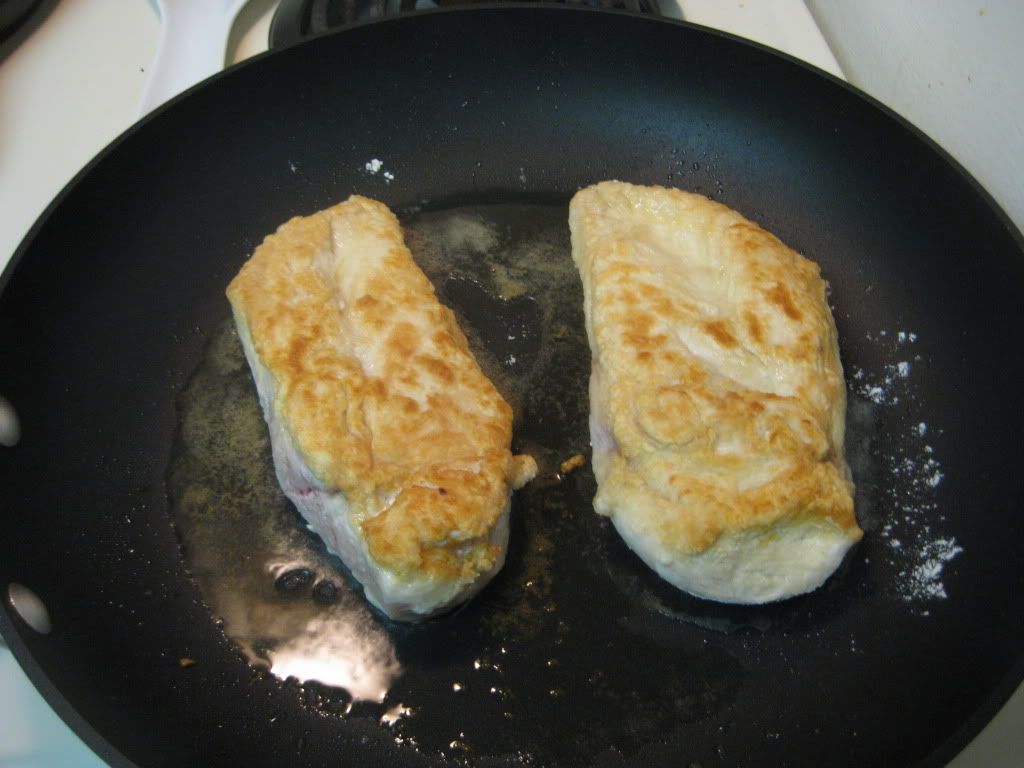 |
| Chicken browning nicely |
Once the chicken is done cooking, there should be enough fat to start the pan sauce. Add the finely chopped garlic to the pan and sauté over high heat until softened, about 20 to 30 seconds. Add the broth, lemon juice, and white wine. Bring to a boil and deglaze the pan, stirring to release any brown bits. Boil until slightly reduced, about three minutes.
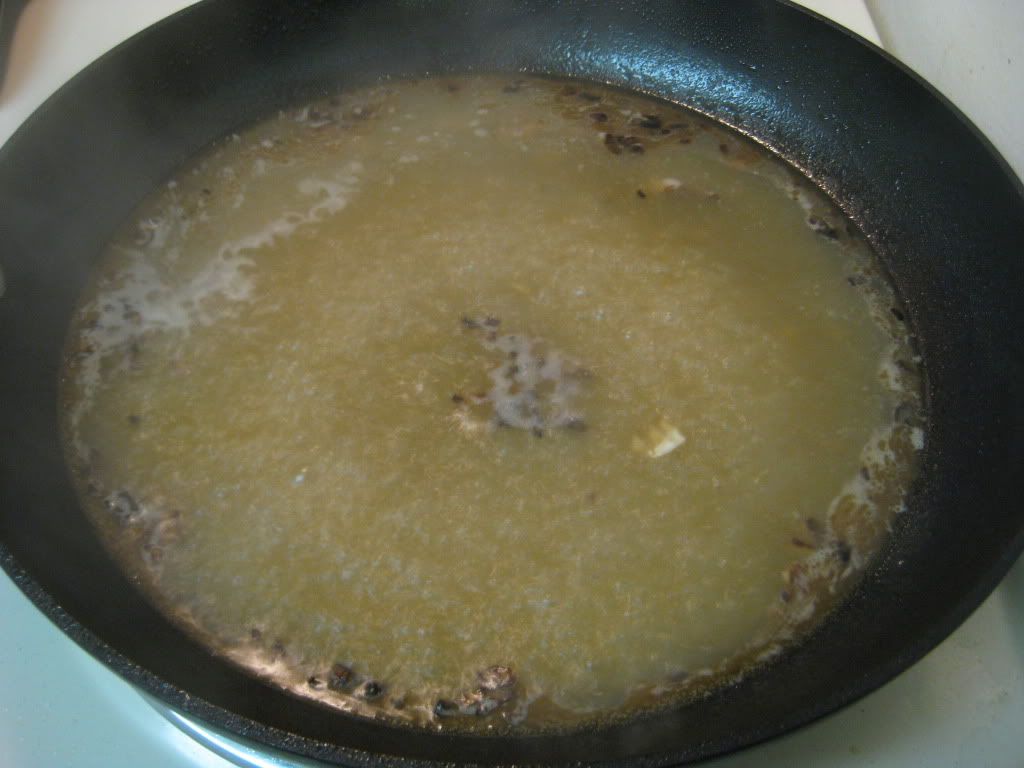 |
| Mmmm...pan sauce... |
Return the chicken to the pan and reduce the heat to medium. Cook until the chicken is opaque throughout, about ten minutes. Raise the heat in the skillet back up to high and boil the pan sauce until reduced to about 1/4 cup, this should take about five minutes. Pour evenly over the chicken and sprinkle and parsley garlic mixture evenly over the top. Serve and enjoy!
The End Result:
The chicken was cooked to perfection (no smoke blanketing the apartment tonight!) The flour coating gave it a good, solid base to soak up any flavors from the dish. The pan sauce was, in a word, tart...very tart. The lemon was almost too much for this dish and gave it an eye popping zing. Even Tyler, who loves anything lemon, said it was very tart, even for his liking. The parsley garlic topping was a wee much as well - I ended up scrapping it off because the flavors were too overpowering. But overall, this dish had good promise and was perfectly cooked the way it was. It was just the flavors that made it overpowering.
I'd recommend cutting the lemon juice in about half for the pan sauce and maybe even reducing the amount of zest used in the recipe. It's got great lemon flavor - just a little too much lemon flavor. It's a solid base for a recipe and with a few tweaks, you can make it into one fantastic dish!
Check back with us on Thursday when Tyler takes to the kitchen, with another chicken recipe - but this one uses a new cooking technique and includes a very interesting way to cook a delicious side dish. Until then,
~Cheers
Monday, August 22, 2011
Around The Culinary World
Good evening everyone! We're back to our regularly scheduled blogging for this week - and boy oh boy has the culinary world delivered. We're packed to the brim with new and interesting stories for this week's feature. So, in a world where Libya is in turmoil, our economy is circling the drain and US politicians are proving themselves even more dense than we first thought... let's distract ourselves with stories about food & cooking!
It's tough to be a fan of alcohol in Utah (apparently). The state is well known for its tight restrictions on restaurants and other vendors and it's trying to add to its no nonsense booze stance by banning mini-kegs. Of course, the consumer (and manufacturers) are one step ahead of the state's new law that bans 5.0 liter kegs. Recently introduced into the market? 4.99 liter kegs! Read the story HERE.
It's tough to be a fan of alcohol in Utah (apparently). The state is well known for its tight restrictions on restaurants and other vendors and it's trying to add to its no nonsense booze stance by banning mini-kegs. Of course, the consumer (and manufacturers) are one step ahead of the state's new law that bans 5.0 liter kegs. Recently introduced into the market? 4.99 liter kegs! Read the story HERE.
 |
| Fare thee well, tiny keg |
In a move that is LONG overdue - Burger King announced this weekend that it was firing their 'King'. The large headed plastic harbinger of fear mascot will no longer appear in television commercials or print ads. Frankly, this campaign was stale before it started. The ads came across as creepy and not at all funny. The new campaign is supposed to feature fresh ingredients and play up avocados as a new healthy menu item. Huh - I guess originality isn't that important to BK then? Read about the firing of the 'King' HERE.
Did you know you're not supposed to use ketchup on your hot dog? No seriously - there is a council (The National Hot Dog & Sausage Council) Yes, it's real - that has codified the rule in their 'Hot Dog Etiquette and Everyday Guidance For Eating America's Sacred Food' Yeah - apparently this is a big deal to some people. In fact, this debate has gone all the way to court - Oscar Meyer recently found themselves defending their 'America's Favorite Hotdog' claim and when the issue of adding ketchup to the dog was raised the judge alluded to this very paper! This is a fairly complicated (yet oh so unintentionally humorous) story. President Obama even weighs in - Read all about the great hot do debate HERE.
Here's a great example of how a company can use their social networks to reach out to customers and fix their mistakes. Chipotle almost fell into a PR disaster last week when it was revealed that their pinto beans were being cooked in bacon grease. What's the big deal you ask? Well, if you're a vegan - that undisclosed bacon grease causes to break your vegan ways. When one customer noticed this disclosure in the fine print they called Chipotle on it via Twitter. Instead of feeding the guy a PR line and simply hoping this issue would go away, Chipotle stepped up to the plate. They fixed their menu to disclose this issue and Chipotle's CEO directly contacted the customer in question to discuss the issue and inform him of the fixes they were putting in place. Round of applause for Chipotle for not only fixing their mistake but making use of social media as a way to improve their customer service. Well done! (Read the full story HERE).
On the opposite end of social media PR is the Houston based bar Down House. A patron of this bar issued a tweet (let's just say it wasn't the nicest tweet) in regards to the bartender and her opinion about him. The manager of Down House saw this tweet and proceeded to call the bar and (allegedly) yell at the customer over the phone before throwing her out. Now - is the customer in question deserving of some of this fire? Yes, I think you have to be careful about what you say about people, especially in today's social media heavy world. However, the manager of Down House has to realize that even if the customer is 100% deserving of begin thrown out - there are better ways to handle the situation than completely blowing up and tossing the patron out of the bar. In the end, both sides look bad and nobody really 'wins' this dispute. All anyway can take away from this is that social media can be your best friend or a complete nightmare - it's all in how you manage it.
Ready for a trip down memory lane? Buzzfeed has composed a list of 25 foods that you'll never be able to eat again (not in a - now that you know about X, you'll never want to eat X again way. It refers to foods that are no longer made). How many foods on this list did you used to enjoy? I have quite a few that I remember as a kid. I think I might be the only person that actually liked Pepsi Blue... See the slideshow HERE.
How do children convince their parents to buy them junk food - one scientist has a theory and it's called the "Nag Factor" Read about the study (and why children feel the need to feed their faces with this junk) HERE.
 |
| BUY ME BUY ME BUY ME!! |
There you have it folks! All the news that's fit to blog about for this week. We're back to a regular schedule for the rest of the week with two new recipes on Tuesday and Thursday night. Be sure to stop in Tuesday night to see what we've got cooking. Until then,
~Cheers
Thursday, August 18, 2011
Classic Comfort Food
Good evening everyone! After last week's busy schedule forced me to bow out of cooking for the week, I'm back tonight and ready to jump back into the kitchen. My dish tonight comes from France - but not in the way you might assume. Dishes like Coq Au Vin and Chicken Cordon Bleu are probably the most common things you think of when some one says 'French cooking' - and for the most part - you'd be correct. My dish tonight, however, comes from the more traditional French cookbook - French country beef stew is France's version of 'leftover stew' or at the very least on of the more common meals cooked for the average French household. Composed of common items that would be found in any pantry - this dish is the ultimate low cost, high yield recipe. Let's get cooking!
The Recipe: French Country Beef Stew
Original Recipe Found On: Eatingwell.com
What You'll Need:
2 Teaspoons Extra Virgin Olive Oil
4 Slices Turkey Bacon (Chopped)
1 1/2 Cups Finely Chopped Onion (Roughly 2 Medium)
1/2 Cup Diced Celery (1 Rib)
1 1/2 Cups Diced Carrots (2 Medium carrots)
3 Cups Reduced Sodium Beef Broth
2 Cups Red Wine
1/2 Teaspoon Dried Thyme
2 Bay Leaves
3 1/2 - 4 Pound Beef Shank or 2 - 3 Pound Stewing Beef (We are using stewing beef)
1/2 Cup Chopped Fresh Parsley
Egg Noodles or Rice To Serve Upon (Optional)
Begin by heating your oil in a large dutch oven until the oil begins to shimmer. (Medium heat) Next, add the chopped slices of bacon and cook until golden brown, roughly 5 to 7 minutes. You may notice in the picture that my bacon slices are rather large. I was using bacon that we had stored in the freezer (from a previous recipe) and so I approached this step slightly differently. I cooked the bacon until it was thawed, then, using kitchen scissors, I chopped up the bacon right in the dutch oven.
Next, add the onions, carrots and celery and cook (stirring often) until the vegetables soften. This should take about 8 to 10 minutes.
This celery, onion & carrot mixture is known as mirepoix - and if you do a lot of French inspired cooking, chances are you've seen this a lot. Mirepoix is a great base for stews and soups - in fact, even the roast I made two weeks ago used mirepoix as a base at the beginning. Pay attention to the next roast, stew or soup recipe you make - you might be surprised to see that mirepoix is the base of the dish.
Once the vegetables are softened, add the beef broth, red wine, thyme and bay leaves and bring the mixture to a boil.
This beef broth and red wine mixture is another common base for stews and soups. Beef broth and red wine naturally combine to create a rich flavor and the when reduced, both will intensify that flavor. As such, any stew or slow roast recipe you try (that involves beef) will likely use this old time French staple. It's funny to see how some of these classic cooking ideas have endured throughout generations. Mirepoix and beef broth/red wine are as old as French cooking itself, and yet they still routinely show up in many of today's contemporary dishes.
Once the mixture is boiling, place your beef shank or stewed beef pieces (cubed) into a slow cooker. Pour the vegetable mixture over the top of the beef and set the cooker on low. Allow this to cook for about 6 hours before moving on to the next stage.
Once the beef has roasted the day away, it's time to reduce this great sauce you've created. Reducing the sauce will do two things. First, it will thicken the mixture by boiling a lot of the excess moisture (read: water) from the sauce. Secondly, it intensifies the flavor of the sauce - because, as we said - you're boiling out the water. (Less water to dilute the natural flavors means more flavor!)
Carefully fish out the beef pieces and set them in a bowl momentarily. Remove and discard the bay leaves. Pour the sauce/vegetable mixture into a large saucepan and set the pan on medium high heat. Bring the mixture to a boil and cook for 10 to 15 minutes or until the sauce begins to thicken. Return the beef to the sauce and heat through (roughly 5 minutes) - serve this stew over egg noodles, rice, barley or any other grain of your choice and enjoy!
The Results:
If we've said it once, we've said it a thousand times. Sometimes, simplicity is the greatest victory in cooking. This dish is based on two very simple concepts - mirepoix and beef broth + red wine. What you end up with is a brilliantly deep and complex flavor that simply blows any other beef stew you've ever had right out of the bowl. There is a reason some of these cooking traditions have lasted as long as they have!
I ended up making a last minute change to this recipe. Instead of serving it as a sort of gravy over the noodles, I opted to add corn starch and thicken up the mixture to a more stew like level. This little tweak is the nice part about cooking. You can make, adapt and tweak a recipe to your needs and whims.
That's all we have for you this week. We're back on a regular schedule on Monday with another edition of Around The Culinary World and two new recipes will follow during the week. Until then,
~Cheers
The Recipe: French Country Beef Stew
Original Recipe Found On: Eatingwell.com
What You'll Need:
2 Teaspoons Extra Virgin Olive Oil
4 Slices Turkey Bacon (Chopped)
1 1/2 Cups Finely Chopped Onion (Roughly 2 Medium)
1/2 Cup Diced Celery (1 Rib)
1 1/2 Cups Diced Carrots (2 Medium carrots)
3 Cups Reduced Sodium Beef Broth
2 Cups Red Wine
1/2 Teaspoon Dried Thyme
2 Bay Leaves
3 1/2 - 4 Pound Beef Shank or 2 - 3 Pound Stewing Beef (We are using stewing beef)
1/2 Cup Chopped Fresh Parsley
Egg Noodles or Rice To Serve Upon (Optional)
Begin by heating your oil in a large dutch oven until the oil begins to shimmer. (Medium heat) Next, add the chopped slices of bacon and cook until golden brown, roughly 5 to 7 minutes. You may notice in the picture that my bacon slices are rather large. I was using bacon that we had stored in the freezer (from a previous recipe) and so I approached this step slightly differently. I cooked the bacon until it was thawed, then, using kitchen scissors, I chopped up the bacon right in the dutch oven.
Next, add the onions, carrots and celery and cook (stirring often) until the vegetables soften. This should take about 8 to 10 minutes.
This celery, onion & carrot mixture is known as mirepoix - and if you do a lot of French inspired cooking, chances are you've seen this a lot. Mirepoix is a great base for stews and soups - in fact, even the roast I made two weeks ago used mirepoix as a base at the beginning. Pay attention to the next roast, stew or soup recipe you make - you might be surprised to see that mirepoix is the base of the dish.
Once the vegetables are softened, add the beef broth, red wine, thyme and bay leaves and bring the mixture to a boil.
This beef broth and red wine mixture is another common base for stews and soups. Beef broth and red wine naturally combine to create a rich flavor and the when reduced, both will intensify that flavor. As such, any stew or slow roast recipe you try (that involves beef) will likely use this old time French staple. It's funny to see how some of these classic cooking ideas have endured throughout generations. Mirepoix and beef broth/red wine are as old as French cooking itself, and yet they still routinely show up in many of today's contemporary dishes.
Once the mixture is boiling, place your beef shank or stewed beef pieces (cubed) into a slow cooker. Pour the vegetable mixture over the top of the beef and set the cooker on low. Allow this to cook for about 6 hours before moving on to the next stage.
Once the beef has roasted the day away, it's time to reduce this great sauce you've created. Reducing the sauce will do two things. First, it will thicken the mixture by boiling a lot of the excess moisture (read: water) from the sauce. Secondly, it intensifies the flavor of the sauce - because, as we said - you're boiling out the water. (Less water to dilute the natural flavors means more flavor!)
Carefully fish out the beef pieces and set them in a bowl momentarily. Remove and discard the bay leaves. Pour the sauce/vegetable mixture into a large saucepan and set the pan on medium high heat. Bring the mixture to a boil and cook for 10 to 15 minutes or until the sauce begins to thicken. Return the beef to the sauce and heat through (roughly 5 minutes) - serve this stew over egg noodles, rice, barley or any other grain of your choice and enjoy!
The Results:
If we've said it once, we've said it a thousand times. Sometimes, simplicity is the greatest victory in cooking. This dish is based on two very simple concepts - mirepoix and beef broth + red wine. What you end up with is a brilliantly deep and complex flavor that simply blows any other beef stew you've ever had right out of the bowl. There is a reason some of these cooking traditions have lasted as long as they have!
I ended up making a last minute change to this recipe. Instead of serving it as a sort of gravy over the noodles, I opted to add corn starch and thicken up the mixture to a more stew like level. This little tweak is the nice part about cooking. You can make, adapt and tweak a recipe to your needs and whims.
That's all we have for you this week. We're back on a regular schedule on Monday with another edition of Around The Culinary World and two new recipes will follow during the week. Until then,
~Cheers
Tuesday, August 16, 2011
Super Salmon
Good evening everyone! After a sligthly longer than usual hiatus from blogging (thanks in part to us traveling back home to attend the wedding of a good friend of ours from high school) we've returned to the cooking world! Maggie is getting us started this week after a lot of 'learning experiences' from last week's recipe. I'll turn the keyboard over to Maggie and let her jump right in!
Hello again everyone! After last week's forray into the smoking chicken (and our apartment smelling like smoke,) its time to dust myself off and try again. I'm dabbling into fish and I find myself a tad nervous, per usual. Fish is a very finicky item to cook, especially if you're not used to it. Tyler has used it enough that he's mastered the ins and outs of the little buggers - I haven't had the fortune of as much experience. Tonight incorporates a new method of cooking that I haven't used before too! Hopefully it will result in something rather tasty!
The Recipe: Pepper and Garlic Panko Crusted Salmon
Original Recipe Found In: www.princesshouse.com (They have excellent kitchen items for sale)
What You'll Need:
⅔ Cup Panko (Japanese dried bread crumbs)
2 Tablesppoons Fresh Parsley, minced
1 Teaspoon Garlic, Pepper, Salt Seasoning Blend
3 Tablespoons Grapeseed Oil, divided
4 (6-8 oz.) Salmon Fillets, skin on
2 Tablespoons Dijon Mustard
1 Lemon, cut into wedges
To start, preheat an oven to 425 degrees. Meanwhile, mix together, in a small bowl, the panko, parsley, and seasoning blend. Drizzle this combination with the oil until the crumbs are evenly coated. Since I did get this recipe out of a catalog that sells kitchen utensils and one of the ingredients of the recipe is the seasoning blend (customized for the catalog), I thought it might be hard to adapt. But, you can use equal parts of garlic powder, pepper, and salt and create a seasoning blend with that - it might not be the same thing but at the very least you can come close. Once again, creativity strikes in the kitchen!
Place the salmon fillets skin side down and generously top with mustard. Press the panko mixture thickly on top of the mustard covered salmon fillet.
Heat one tablespoon of oil over medium high heat in a oven-safe skillet or Dutch oven. When the oil is shimmering, add the salmon fillets skin side down. Sear for three to four minutes, without turning, to brown the skin. Transfer the pan to the oven and cook for five to seven minutes, until the salmon is almost cooked and the panko is browned.
Remove from the oven, cover with a lid and allow to rest for five to ten minutes. I have never seen this method used before in cooking. I know that fish doesn't take that long to cook, but I think covering it will allow the heat from the pan to circulate in the covered dish. Thus cooking it more and giving it a better flavor - almost like it was roasted. After ten minutes, serve the salmon with lemon wedges, and enjoy!
The End Result:
Oh my goodness! Even if you aren't a fish fan, or salmon for that matter, this dish will definitely change your mind. The breading is quite fantastic - the panko adds a nice crunch and the parsley and the seasoning blend creates a flavorful burst. The mustard base gives the salmon an extra oomph. The unique way of cooking made the salmon really moist and cooked out almost all the fishy flavor. The slow cook method at the end prevented the fish from 'oozing' like salmon is prone to do as well. Overall, one great dish that I can add to my fish recipe repertoire.
Join us as Tyler takes to the kitchen on Thursday with a classic dish with French inspirations. Until then,
~Cheers!
Hello again everyone! After last week's forray into the smoking chicken (and our apartment smelling like smoke,) its time to dust myself off and try again. I'm dabbling into fish and I find myself a tad nervous, per usual. Fish is a very finicky item to cook, especially if you're not used to it. Tyler has used it enough that he's mastered the ins and outs of the little buggers - I haven't had the fortune of as much experience. Tonight incorporates a new method of cooking that I haven't used before too! Hopefully it will result in something rather tasty!
The Recipe: Pepper and Garlic Panko Crusted Salmon
Original Recipe Found In: www.princesshouse.com (They have excellent kitchen items for sale)
What You'll Need:
⅔ Cup Panko (Japanese dried bread crumbs)
2 Tablesppoons Fresh Parsley, minced
1 Teaspoon Garlic, Pepper, Salt Seasoning Blend
3 Tablespoons Grapeseed Oil, divided
4 (6-8 oz.) Salmon Fillets, skin on
2 Tablespoons Dijon Mustard
1 Lemon, cut into wedges
To start, preheat an oven to 425 degrees. Meanwhile, mix together, in a small bowl, the panko, parsley, and seasoning blend. Drizzle this combination with the oil until the crumbs are evenly coated. Since I did get this recipe out of a catalog that sells kitchen utensils and one of the ingredients of the recipe is the seasoning blend (customized for the catalog), I thought it might be hard to adapt. But, you can use equal parts of garlic powder, pepper, and salt and create a seasoning blend with that - it might not be the same thing but at the very least you can come close. Once again, creativity strikes in the kitchen!
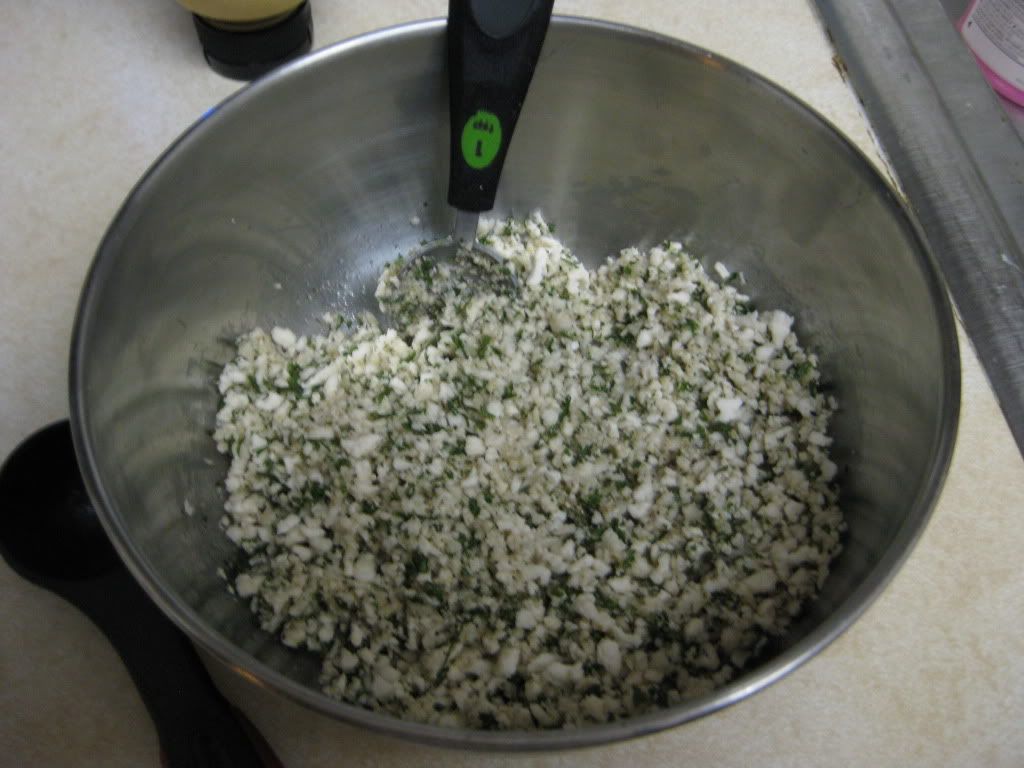 |
| Panko, parsley, and seasoning blend, ready to roll! |
Place the salmon fillets skin side down and generously top with mustard. Press the panko mixture thickly on top of the mustard covered salmon fillet.
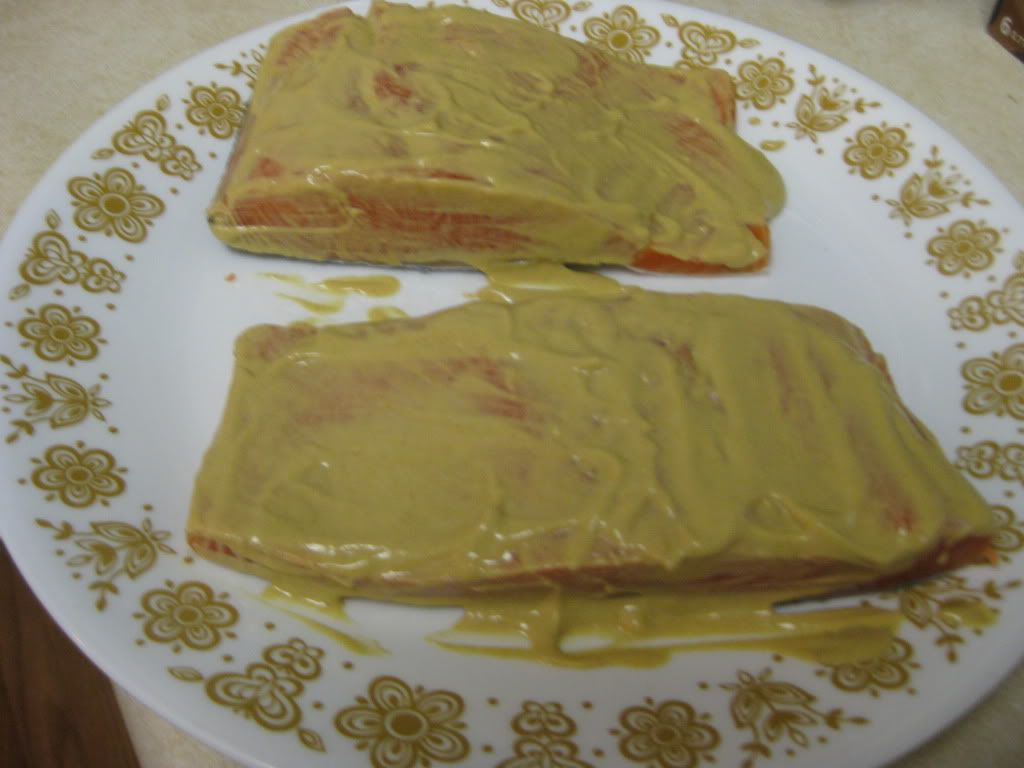 |
| Smothered in mustard |
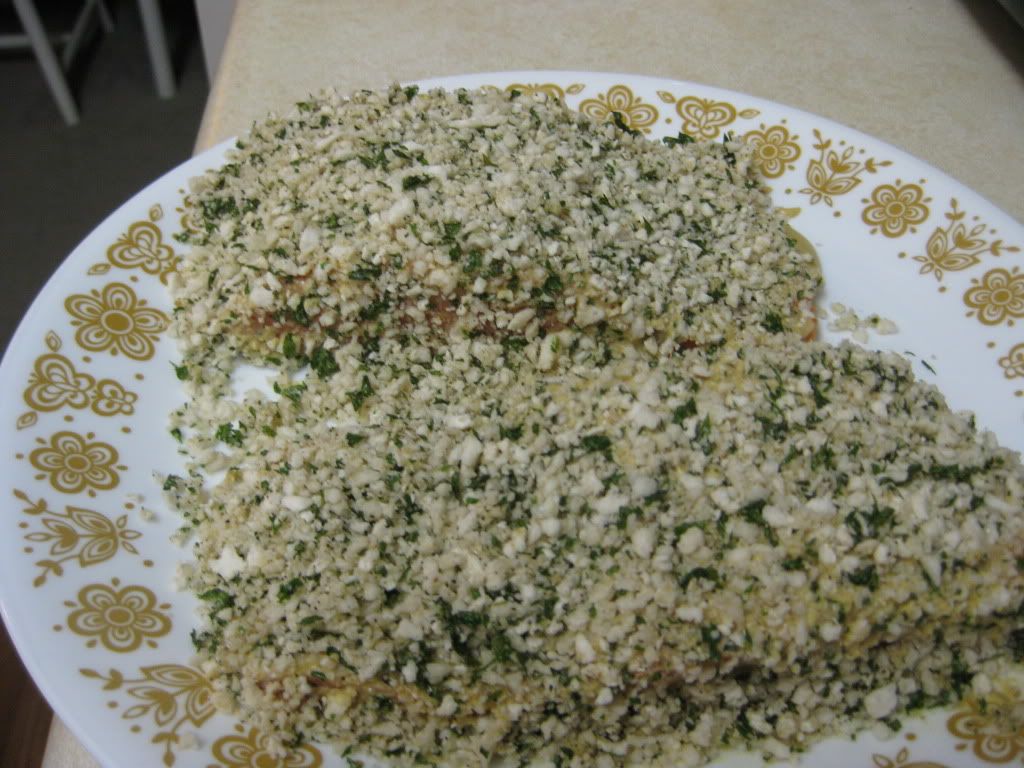 |
| Ready to sear and bake! |
Heat one tablespoon of oil over medium high heat in a oven-safe skillet or Dutch oven. When the oil is shimmering, add the salmon fillets skin side down. Sear for three to four minutes, without turning, to brown the skin. Transfer the pan to the oven and cook for five to seven minutes, until the salmon is almost cooked and the panko is browned.
Remove from the oven, cover with a lid and allow to rest for five to ten minutes. I have never seen this method used before in cooking. I know that fish doesn't take that long to cook, but I think covering it will allow the heat from the pan to circulate in the covered dish. Thus cooking it more and giving it a better flavor - almost like it was roasted. After ten minutes, serve the salmon with lemon wedges, and enjoy!
The End Result:
Oh my goodness! Even if you aren't a fish fan, or salmon for that matter, this dish will definitely change your mind. The breading is quite fantastic - the panko adds a nice crunch and the parsley and the seasoning blend creates a flavorful burst. The mustard base gives the salmon an extra oomph. The unique way of cooking made the salmon really moist and cooked out almost all the fishy flavor. The slow cook method at the end prevented the fish from 'oozing' like salmon is prone to do as well. Overall, one great dish that I can add to my fish recipe repertoire.
Join us as Tyler takes to the kitchen on Thursday with a classic dish with French inspirations. Until then,
~Cheers!
Thursday, August 11, 2011
Recipe Flashback: Fried Chicken (And a little science to boot!)
Good evening everyone! After Maggie's learning experience with smoke point & chicken last night - I got to thinking about a similar run in I had a little over a year ago. Since our work schedule this week is - to put it nicely - hectic, we only really had time to work in one new recipe for the week. So, with our learning experience from last night fresh in our mind I thought tonight would be a great time to feature a dish from last summer where I learned all about smoke point.
For those who aren't aware, smoke point is the point where a liquid (usually a fat or an oil) will begin smoking when it reaches a certain temperature. The temperatures usually vary between oils - that's the reason you'll see some recipes call for a light vegetable oil or a heavier olive oil. The chef is taking in to account pan temperature and is trying to bring out or avoid the smoke point of the oil.
Certain oils undergo a flavor transformation when they hit or near their smoke point - which is why some recipes call for the oil to be heated until just smoking. Usually these recipes typically add something immediatly to the skillet or pot, which instantly drops the temperature of the oil - thereby ending the smoking. The flavor transformation has happened and the smoking has stopped - win win for the at home chef.
Last night, Maggie ran into an insteresting situation that I didn't anticipate. She switched the called for chicken - drumsticks - for chicken we had on hand - chicken thighs. Typically this wouldn't raise a problem in a recipe. The two perform fairly similarly and aside from adjusting cooking time slightly - you don't really have to worry about much change.
However, there was one difference between drumsticks and thighs that came into play - fat content. Chicken thighs are significantly fatter than drumsticks (logically, look at 98% of human legs for example. You thighs are likely larger and a bit more fatty than your legs). Her recipe called for 12 drumsticks, which she reduced to 4 chicken thighs (only cooking for two - we didn't need any more). She otherwise followed all of the instructions and created an unintentional perfect storm in the oven.
Now, I'm only theorizing here because I don't have the exact temperature measurements from the oven, but I believe that this is what happened. Fewer pieces of meat in an oven without adjusting the original temperature likely resulted in each piece of chicken being cooked at a slightly higher temperature. (It's the 'crowded skillet' theory - the more you add to a skillet, the more the heat is distributed, thereby lowering the overall temperature of each item in the skillet - the same concept should apply in the oven)
This higher temperature caused the fat from the chicken to melt earlier in the cooking process, creating a fatty 'oil' at the bottom of her baking sheet. Now, as we said there is more fat on a thigh than a drumstick, so you are creating more oil. After about 10 minutes cooking, light smoke began to rise from the baking sheet - this was actually expected (this is a common problem with chicken in an oven) and was nothing that our overhead range couldn't fan away. After another 5 minutes, however, we clearly had an issue. The oven was producing more smoke than the fan could keep up with and we were quickly opening windows and attempting to pull the air from the apartment.
So in short: 1) fewer pieces of meat in an oven set for 12 pieces resulted in each piece heating up faster and at a higher temperature than called for. 2) This resulted in the fat melting into an oil earlier than it would have with 12 pieces. 3) Thighs in place of drumsticks allowed for much more fat to be melted. 4) Larger pool of oil earlier in the cooking process allowed the smoke point to be reached about 1/2 way through cooking - causing a lot of smoke during cooking.
In the end, it still turned out to be a fairly good recipe! I'd caution against following Maggie's method to a 'T' however. You can use thighs, I would simply drop the temperature by 25 degrees and increase the cooking time by about 5-10 minutes. That should prevent the fat from hitting a smoke point - or you could simply follow the original recipe as 12 drumsticks will likely not hit a smoke point until the very end of cooking and will likely not produce much smoke at all.
All in all we learned a lot. I thought I'd start tonight's blog off by sharing what exactly went wrong with last night's recipe and how we found to correct it. Maggie doesn't like to be as verbose in her blog posts as I do and she sort of skimmed over the 'why' last night.
Now, let's get into the real reason you're all here - RECIPES! Maggie's learning experience brought up memories of my very own smoke point learning experience - and just like Maggie I still ended up with a decent recipe despite all of the rolling smoke. Let's dive in to a dish from last 'season' a revisit an Out Of The Culinary classic: Fried Chicken
For those who aren't aware, smoke point is the point where a liquid (usually a fat or an oil) will begin smoking when it reaches a certain temperature. The temperatures usually vary between oils - that's the reason you'll see some recipes call for a light vegetable oil or a heavier olive oil. The chef is taking in to account pan temperature and is trying to bring out or avoid the smoke point of the oil.
Certain oils undergo a flavor transformation when they hit or near their smoke point - which is why some recipes call for the oil to be heated until just smoking. Usually these recipes typically add something immediatly to the skillet or pot, which instantly drops the temperature of the oil - thereby ending the smoking. The flavor transformation has happened and the smoking has stopped - win win for the at home chef.
Last night, Maggie ran into an insteresting situation that I didn't anticipate. She switched the called for chicken - drumsticks - for chicken we had on hand - chicken thighs. Typically this wouldn't raise a problem in a recipe. The two perform fairly similarly and aside from adjusting cooking time slightly - you don't really have to worry about much change.
However, there was one difference between drumsticks and thighs that came into play - fat content. Chicken thighs are significantly fatter than drumsticks (logically, look at 98% of human legs for example. You thighs are likely larger and a bit more fatty than your legs). Her recipe called for 12 drumsticks, which she reduced to 4 chicken thighs (only cooking for two - we didn't need any more). She otherwise followed all of the instructions and created an unintentional perfect storm in the oven.
Now, I'm only theorizing here because I don't have the exact temperature measurements from the oven, but I believe that this is what happened. Fewer pieces of meat in an oven without adjusting the original temperature likely resulted in each piece of chicken being cooked at a slightly higher temperature. (It's the 'crowded skillet' theory - the more you add to a skillet, the more the heat is distributed, thereby lowering the overall temperature of each item in the skillet - the same concept should apply in the oven)
This higher temperature caused the fat from the chicken to melt earlier in the cooking process, creating a fatty 'oil' at the bottom of her baking sheet. Now, as we said there is more fat on a thigh than a drumstick, so you are creating more oil. After about 10 minutes cooking, light smoke began to rise from the baking sheet - this was actually expected (this is a common problem with chicken in an oven) and was nothing that our overhead range couldn't fan away. After another 5 minutes, however, we clearly had an issue. The oven was producing more smoke than the fan could keep up with and we were quickly opening windows and attempting to pull the air from the apartment.
So in short: 1) fewer pieces of meat in an oven set for 12 pieces resulted in each piece heating up faster and at a higher temperature than called for. 2) This resulted in the fat melting into an oil earlier than it would have with 12 pieces. 3) Thighs in place of drumsticks allowed for much more fat to be melted. 4) Larger pool of oil earlier in the cooking process allowed the smoke point to be reached about 1/2 way through cooking - causing a lot of smoke during cooking.
In the end, it still turned out to be a fairly good recipe! I'd caution against following Maggie's method to a 'T' however. You can use thighs, I would simply drop the temperature by 25 degrees and increase the cooking time by about 5-10 minutes. That should prevent the fat from hitting a smoke point - or you could simply follow the original recipe as 12 drumsticks will likely not hit a smoke point until the very end of cooking and will likely not produce much smoke at all.
All in all we learned a lot. I thought I'd start tonight's blog off by sharing what exactly went wrong with last night's recipe and how we found to correct it. Maggie doesn't like to be as verbose in her blog posts as I do and she sort of skimmed over the 'why' last night.
Now, let's get into the real reason you're all here - RECIPES! Maggie's learning experience brought up memories of my very own smoke point learning experience - and just like Maggie I still ended up with a decent recipe despite all of the rolling smoke. Let's dive in to a dish from last 'season' a revisit an Out Of The Culinary classic: Fried Chicken
The Recipe: Easier Fried Chicken
Original Recipe Found In: Cook's Illustrated September / October 2010 Issue
What You'll Need:
1 1/4 Cups Buttermilk
Table Salt
Hot Sauce
3 Teaspoons Ground Black Pepper
1 Teaspoon Garlic Powder
1 Teaspoon Paprika
1/4 Teaspoon Cayenne Pepper
3 1/2 Pounds Bone-In, Skin On Chicken Pieces (We used thighs and drumsticks)
2 Cups Unbleached All Purpose Flour
1 3/4 Cups Vegetable Oil
This recipe begins by using the cooking process known as 'brining'. Brine, as you may know, is water that is saturated with salt. Many meats (especially turkey and chicken) that are fried or roasted are brined before cooking because the salt changes the chemical makeup of the meat, allowing it to retain more moisture (I.E. Juicy goodness) during cooking.
In addition, most fried chicken is soaked in some form of buttermilk before frying. The lactic acid in buttermilk tenderizes the meat, causing the finished dish to be extremely tender and soft. Some recipes may call for other forms of milk, such as whole milk - but the lactic acid in those milks are much more intense than buttermilk. The milder acid in buttermilk will tenderize you meat, but not turn it into a gooey ooze if you leave it in the marinade too long.
For this recipe, we combine both practices into one easy step. By saturating the buttermilk with salt, you effectively turn the buttermilk into brine. These two work together - first the buttermilk (and the lactic acid) activate the cathespin enzymes in the meat. These enzymes break down the proteins into small molecules - effectively tenderizing the chicken. The salt meanwhile, changes the protein in the meat so that it will retain more moisture, even under intense heat. It's a perfect partnership that will lead to delicious fried chicken.
To make your own buttermilk / brine super team, begin by whisking 1 cup of buttermilk, 1 tablespoon of salt, 1 teaspoon black pepper, a dash of hot sauce, 1/4 teaspoon garlic powder, 1/4 teaspoon paprika and a pinch of cayenne pepper in a large bowl. Drop your chicken pieces into the bowl and turn over a few times to ensure an even coating. Cover the bowl with plastic wrap and let sit for at least one hour. You can let the chicken soak overnight if you wish (I opted to make this brine the day before and let the chicken soak all day until I came home from work).
 |
| Giving the chicken an overnight bath |
Once you have brined to your heart's content, adjust your oven rack to the middle position and preheat to 400 degrees. In a large bowl, whisk your flour, baking powder, 1 teaspoon of salt, the remaining 2 teaspoons of black pepper, as well as the remaining garlic powder and and paprika. Add a another dash of cayenne pepper to this mixture as well. (The baking powder releases carbon dioxide while cooking which causes the breading to 'pop' and crackle. This leaves a very nice crispy outer crust.)
Using tongs, grab one piece of chicken at a time and roll it in the flour mixture. Turn several times until the entire piece is coated in flour. Don't be afraid to apply liberally. Place the coated chicken on a clean plate and continue the process until all pieces are coated. Once finished, check over all the pieces to search out any dull spots. Sprinkle any remaining flour over those spots.
 |
| Chicken coating assembly line |
Now, things get interesting. Heat 1 3/4 cups of vegetable oil in a 11 inch straight side skillet (or large pot) until it reaches 375 degrees. If you have a hot oil thermometer, congratulations, this should be a breeze. If you don't (like me), this part gets a little tough. It takes about 10 to 15 minutes on medium heat to get the oil up to this temperature. During this time the oil will pop out any air bubbles that may be lurking amongst it (sounding like small bouts of gun fire) this throws a lot of oil, so be sure to cover the pan with a splatter screen.
Now, oil smokes when it reaches 375 degrees - that much I knew. However, what I didn't think about (and what the folks at Cook's Illustrated fail to mention AT ALL in their recipe) is that 1 3/4 cup of vegetable oil smokes A LOT....call the fire department, crawl on the floor to see clearly, so thick you cough and can't see....A LOT. Now, this is not too much of an issue if you have a good overhead fan above your stove. We don't.
By the time I noticed the smoke rolling pot, it was already too late. I was working on another aspect of the recipe while I was letting the oil heat up. Bad idea. I turned to find the entire apartment clouded in a wall of smoke. Blinding 'it burns my eyes and hurts my lungs' kind of smoke. Needless to say, an adventure I really wasn't looking for.
After opening the windows, pointing the fans out the door and otherwise completely ventilating the apartment, I was ready to proceed.
Place you chicken pieces (one to three at a time) into the hot oil. Allow to cook for about 2 minutes or until nice and golden brown. Flip the pieces (carefully) and cook the opposite side for another 2 minutes. Set the finished pieces aside on a clean plate and repeat the steps until all the pieces have been fried up.
Now, while your chicken has a nice, golden color to it - it's not ready to eat. If you take the temperature - you'd find that the thighs and drumsticks only register about degrees, well below safe eating levels. So, to finish off the cooking we will turn to the oven. (Which should be a nice and warm 400 degrees by now.)
Place a wire rack inside a baking sheet (as pictured)
and then stack your chicken pieces on the rack. This rack will do two things - first, it will allow the excess fat and grease to drip off of and fall below the chicken (healthy!) secondly, it will allow the air to circulate around the chicken and prevent you from burning the bottom portions. Stick the chicken in the oven for 20 to 25 minutes, or until the breast pieces register 165 degrees and the thighs and drumsticks register 175 degrees. Once at the right temperature, remove the chicken from the oven and let set for 5 minutes before serving.
Now, I chose to make a quick side dish with this recipe. Roasted skillet potatoes sounded like a nice simple choice to compliment the fried chicken. So simple in fact, you don't even need a full recipe to make it. All you need is 2 tablespoons of olive oil, 1 pound of small red potatoes and 15 minutes.
Add your olive oil to a small skillet and heat until shimmering. Meanwhile, slice your red potatoes into halves or quarters (I chose quarters) and rinse well. Set the potatoes on a clean kitchen towel to dry fully. Once dried, place your potatoes, cut side down, into the skillet and cook for 5 minutes. After 5 minutes, rotate the potatoes to either the skin side (if you halved them) or to the other cut side (if you quartered them) and cook for an additional 5 minutes. Next, stir the potatoes well and cover the skillet. Reduce the heat to medium low and cook for an additional 5 minutes. Season with salt and pepper and serve.
The Results:
I was pleasantly surprised with the results. The chicken had a very nice, crunchy and flavorful outer crust (I am not one who usually eats the chicken skin but had to take a bite after all of the work I went to in making it). The meat of the chicken, however, is the real star of this dish. The chicken was incredibly juicy and just loaded with amazing flavors. This was, hands down, one of the top pieces of fried chicken I've had in my lifetime. Oh, and the potatoes were tasty too. Very simple and clean - yet full of natural flavor.
That being said, I'm not sure if I would attempt this recipe again without a significant upgrade in equipment for my kitchen. A pot with a built in oil thermometer is absolutely essential to making this dish without having to call the fire department or disable the smoke detecters (which never did go off...I'm not sure that's a good thing...) Also, a range hood that has a serious fan is essential. I'm not even sure our fan leads outside, and it certainly didn't have the horsepower to keep up with the smoke from frying the chicken. In the end, tonight's recipe wasn't so much difficult to make as it was difficult to execute. We simply lacked the full tools necessary to make this dish without hassle - something to consider before you tackle this one on your own.
***
That's all we have for you this week. We're off on Monday - but back to cooking on Tuesday and Thursday next week. Stop in Tuesday night to see what we've got cooking! Until then,
~Cheers
Subscribe to:
Comments (Atom)

